Everything You Need To Know About Comet Tsuchinshan-ATLAS AKA Comet C/2023 A3
Header Image: Bill Chiu, Comet C/2023 A3 taken in September 2024
Long ago, comets were, to some, seen as omens of future doom. It seems fitting, then, that we get a potentially bright comet during October 2024 to celebrate the spookiest month on our calendar. Here’s an introduction to Comet C/2023 A3—the latest bright comet to grace our skies in the inner solar system.
Considered a long-period comet, Comet C/2023 A3—also known as Comet Tsuchinshan-ATLAS or Comet Purple Mountain-ATLAS—recently made its closest approach to the Sun, after having traveled from the Oort Cloud. It’s forecasted to be brightest on October 9 around magnitude -3, and around magnitude +2 on October 12 when the comet is at its closest point to Earth.
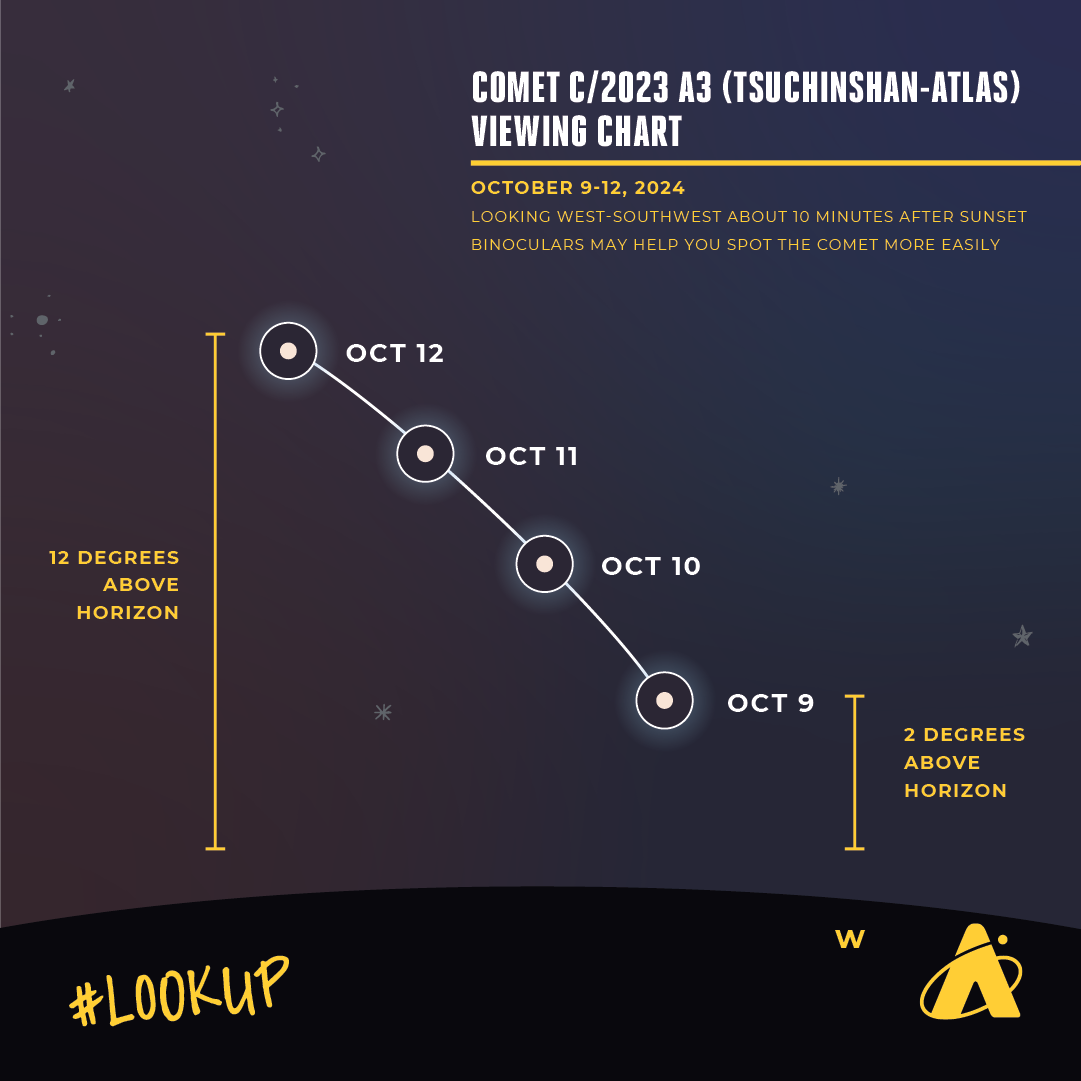
What Is A Comet?
Comets are leftovers from the formation of our solar system, originating in distant reaches far enough from the Sun where it was cold enough for ices to exist. The word “comet” comes from the Latin word “coma,” which means “hair,” because these objects looked very fuzzy and hairy in the sky.
As comets get closer to the Sun, the Sun’s light and heat causes ices in a comet’s nucleus to turn directly from a solid to a gas, creating a coma. As this temporary cloud of material is blown away from the nucleus by the Sun’s light and by the solar wind, multiple comet tails and trails can form.
For a more in depth overview of comets, please read here!
Where Did C/2023 A3 Come From?
Comets get the designation long-period if their orbits are more than 200 years long; C/2023 A3’s orbit is at least 80,000 years long. It most likely came from a region called the Oort Cloud, which is a spherical volume surrounding the planets that may have formed early on in our solar system’s history when icy objects were flung outward away from the Sun due to the gravitational action of the planets. The Oort Cloud has only been theoretically predicted—we’ve never seen Oort Cloud objects out at their vast distances due to their tiny sizes, cold temperatures, and dark color.
The length of its orbital period, how fast it is traveling, and the angle of its orbit all point to C/2023 A3 being an Oort Cloud comet. At some point in the more recent past, something gravitationally jostled C/2023 A3 (such as the gravitational tug of a passing star) causing it to exit the Oort Cloud, and it started to make its way toward the inner region of our solar system!
So, will this comet be visible from Earth again in 80,000 years? Not necessarily. It depends on how fast the comet speeds away from us after encountering the planets and the Sun. If the comet’s speed is not fast enough to escape the Sun’s gravity, it could theoretically visit us again in the distant future. However, if it is given enough of a kick in speed by the gravity of other objects, its orbit could become hyperbolic. This means that it might eventually escape the gravitational pull of the Sun. For comets in extremely elliptical orbits, it doesn’t take much of an influence to have their orbits perturbed by gravity to either slow them down or speed them up. A comet’s first visit here might be its last!
How Bright Will The Comet Get?
That, unfortunately, is one of the hardest questions to answer about comets. No two comets are exactly the same, and we don’t know for sure what a comet is going to do until the Sun’s light and heat interact with it.
One thing to note about comet brightness is that the comet will not be uniformly bright all along its entire length. The end of the tail will usually be fainter than the head, so therefore the head of the comet will likely be the part of the comet that is easiest to see. The full extent of the comet’s tail will probably show up better in photographs.
October 9, 2024–October 12, 2024

One potentially very interesting date for this comet is October 9, 2024. Right at the time of sunset, the comet will be very, very low to the horizon—only a few degrees up. The low angle between the comet and the Sun means that sunlight scattered by dust from the comet might temporarily bump up the comet’s brightness significantly, possibly to around magnitude -2.5, which is about as bright as Jupiter is in our night sky. However, because the comet will be extremely low to the horizon, looking through that much air plus being in so much sunset glare might counteract much of that visual brightness bump. It will also only be above the horizon for about 15 minutes or so after sunset before it sets.
Experienced skywatchers who know exactly where to look may be able to see the comet in the daytime before the Sun sets, but do not attempt this unless you know exactly what you are doing due to the real possibility of permanent eye damage from accidentally viewing the Sun directly.
If you point an unfiltered telescope or pair of binoculars at the Sun, eye damage from the burn will be instantaneous and eyesight loss will be permanent. In other words—just wait until the Sun fully sets to try to find the comet on October 9. Or, better yet, wait another day or two for the comet to be higher in the sky after sunset. It won’t be as bright as it might be on October 9, but at least you won’t risk your vision as much trying to find it. The comet could be nearly as bright just after sunset on October 10, 2024–October 11, 2024.
October 13, 2024–October 31, 2024
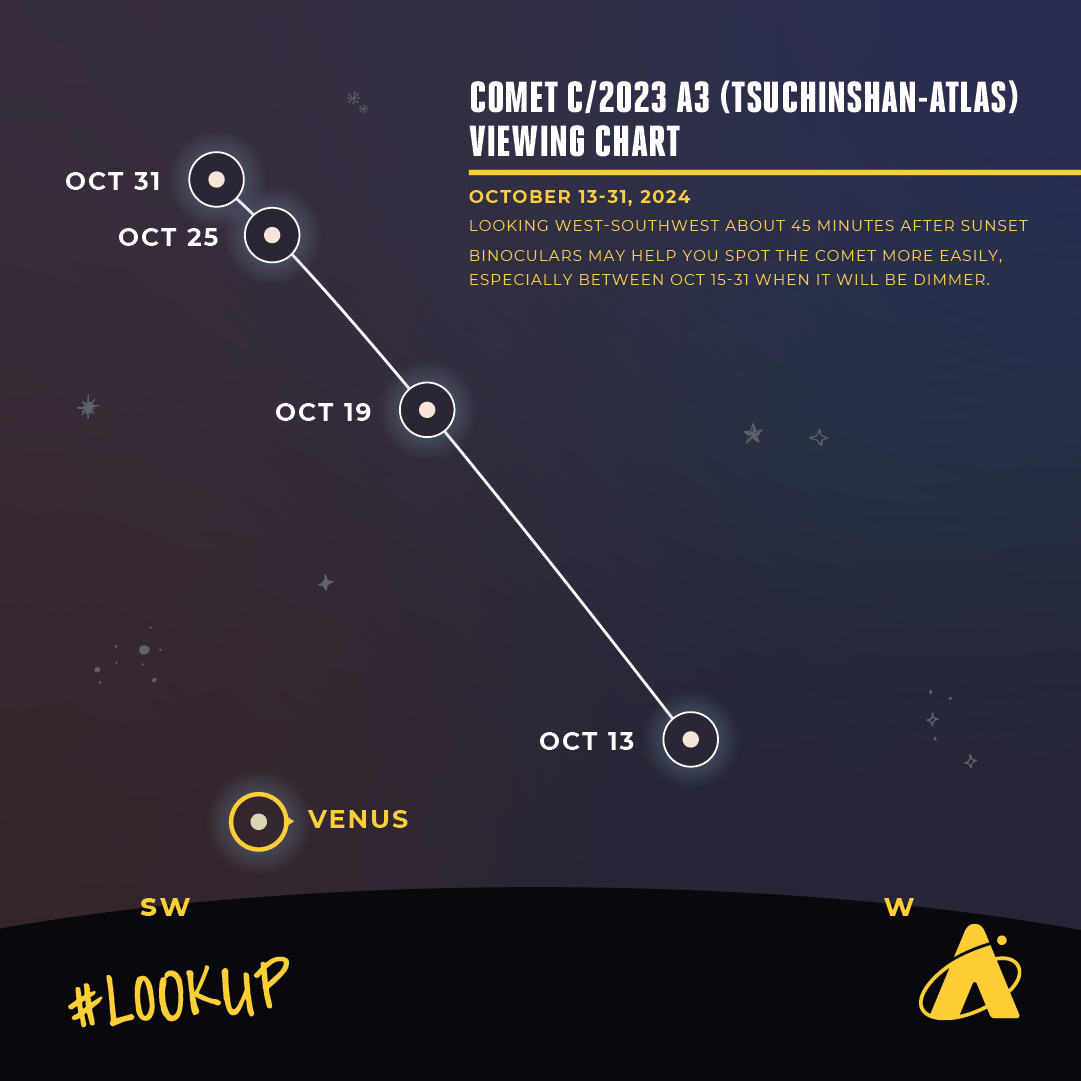
On October 12, 2024–October 13, 2024, the comet will be around magnitude +2, possibly around magnitude +1. Magnitude +2 is about as bright as Polaris in our night sky. It will begin to dim after that date. The Moon’s light may interfere a bit with the brightness of the comet around mid-October, as well. By the end of October 2024, the comet will be a lot dimmer, probably around magnitude +6, which is at the human limit of naked-eye visibility under a very dark sky. Viewers in light polluted locations will need binoculars or a small telescope to see it then.
How Was This Comet Named?
Each part of a comet’s name has a purpose! It helps us identify what kind of comet it is, when it was discovered, and where it was discovered.
Comet C/2023 A3 (Tsuchinshan-ATLAS)’s name can be broken down like this:
- C/ means that this comet is classified as a non-periodic comet, which is the designation for comets that don’t have a regular orbit around the Sun or comets whose orbits are more than 200 years long
- 2023 identifies the year this comet was discovered
- A3 tells us the time period of the year that this comet was discovered with an alphabetic letter and a number to signify how many other comets were discovered in this time period
- A = the first half of January, B = the second half of January, and so on and so forth, except the letter I and Z are never used
- Tsuchinshan-ATLAS = the names of the two observatories that jointly get credit for discovering the comet. Pronunciation: [zz-jing-shan]-ATLAS. Transliteration: Purple Mountain [Observatory]-ATLAS.
Tips and Tricks For Seeing This Comet
- Check the weather beforehand
- Double check that you live or are observing from a latitude that is not too far south to see the comet in the early evening
- Look for a fuzzy object, possibly with a short wispy tail pointing away from the Sun
- When the comet will be closest to Earth, there will be a bright Moon in the sky at the same time that might make naked-eye viewing of the comet a little harder
- Binoculars might help you locate it, especially after October 15, but do not start using binoculars to find it until the Sun has fully set below the horizon. You will cause permanent damage to your eyes from accidentally viewing the Sun directly. If you point an unfiltered telescope or pair of binoculars at the Sun, eye damage from the burn will be instantaneous and eyesight loss will be permanent.
Learn From Our Astronomy Educators
Watch our Sky Observers Hangout livestream on October 15, 2024 starting at 6:00 pm CT to learn what makes these icy bodies tick and how you can catch a view of this comet before it is propelled back out to the far reaches of the solar system—possibly never to be seen again. Weather permitting, our astronomy educators Michelle and Hunter may show a live view of Comet C/2023 A3 as it sets over Chicago’s skyline. Subscribe to the Adler’s YouTube channel to get notifications about upcoming livestreams and new content so you don’t miss an episode!
Adler Skywatch: October 2024
Header image: The full harvest supermoon illuminates the night sky on September 17, 2024. Image credit: Nick Lake
Check out what’s up in the night sky this October!
See Comet C/2023 A3 (Tsuchinshan-ATLAS)

A new comet–with a long name–may become a memorably bright celestial object this month, October 2024.
Comet C/2023 A3 (Tsuchinshan-ATLAS) becomes the latest bright comet to grace our skies in the inner solar system. Comet viewing opportunities abound, especially near the middle of the month. On October 12 and October 13, look for it about 10 degrees above the west-southwest horizon only after the Sun has fully set. The comet will be around magnitude +2, possibly around magnitude +1. It will begin to dim after then. The Moon’s light may also interfere a bit with the brightness of the comet around mid-month.
By the end of the month, the comet will be a lot dimmer, probably around magnitude +6, which is at the human limit of naked-eye visibility under a very dark sky. Viewers in light-polluted locations will definitely need binoculars or a small telescope to see it then. But do not use binoculars or a telescope until after the Sun has fully set.
If you haven’t seen a comet before, they look different from stars or planets. Stars and planets appear as dots of light. Comets are more fuzzy, and with a wispy tail that points away from the Sun.
Supermoon Sighting
Last month’s full Moon was about 223,000 miles away from Earth, which is considerably closer than the average Earth-to-Moon distance of 239,000 miles—making it a supermoon. This month’s full Moon will get even closer to Earth than last month’s, making it the closest full supermoon of 2024! A full supermoon is estimated to appear up to 30 percent brighter and nearly 15 percent bigger than a full Moon at its farthest from Earth.
One description of the size difference between a full Moon and a supermoon compares it to a nickel and a quarter. Now, it’s easy to spot the difference when a nickel and a quarter are side-by-side. But the Moon appears by itself in the sky, so it’s not as easy to compare the difference in size or brightness.

Planet Spotting in October
This month, the brightest planet, Venus, sets in the west-southwest about 75 minutes after the Sun on October 1, and nearly two hours after the Sun by October 31. It gets brighter every day this month too, reaching a brilliant magnitude of minus four around October 24. Look for Venus at least a half-hour after the Sun has entirely set, about ten degrees above the west-southwest horizon early in the month, and about ten degrees above the southwest horizon late in the month. On October 5, spot it above and slightly to the right of a slim, waxing crescent Moon.
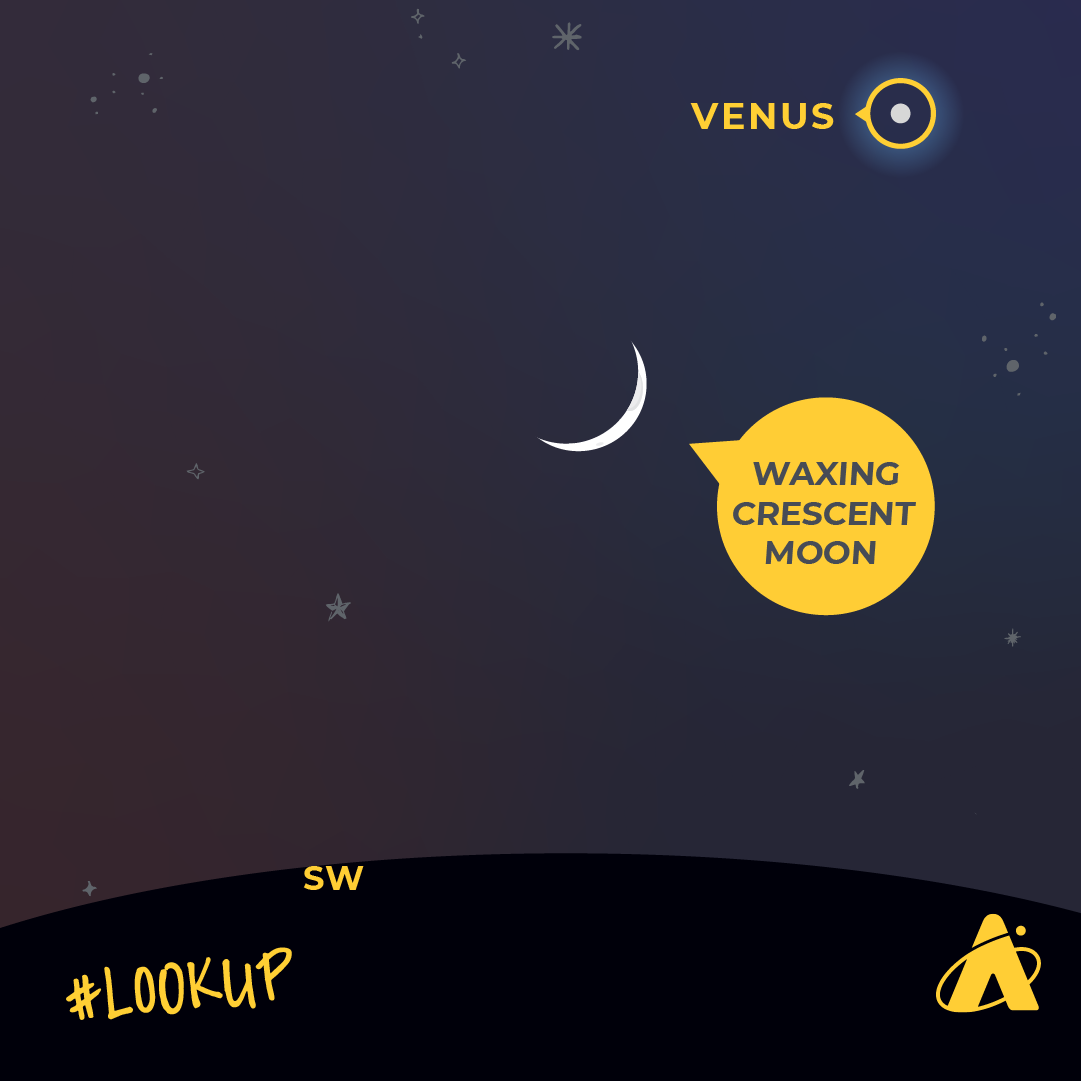
Next, Saturn is low in the east-southeast, just as the Sun is setting in the west-southwest. It’s brighter than magnitude one all month long. At the start of the month, it’s about 50 degrees high in the south at 11:00 pm and at 9:00 pm by month’s end. Saturn sets in the west-southwest about 4:00 am early in the month, and by about 2:00 am by month’s end. On October 4, see Saturn and the Moon traveling south together in the night sky.
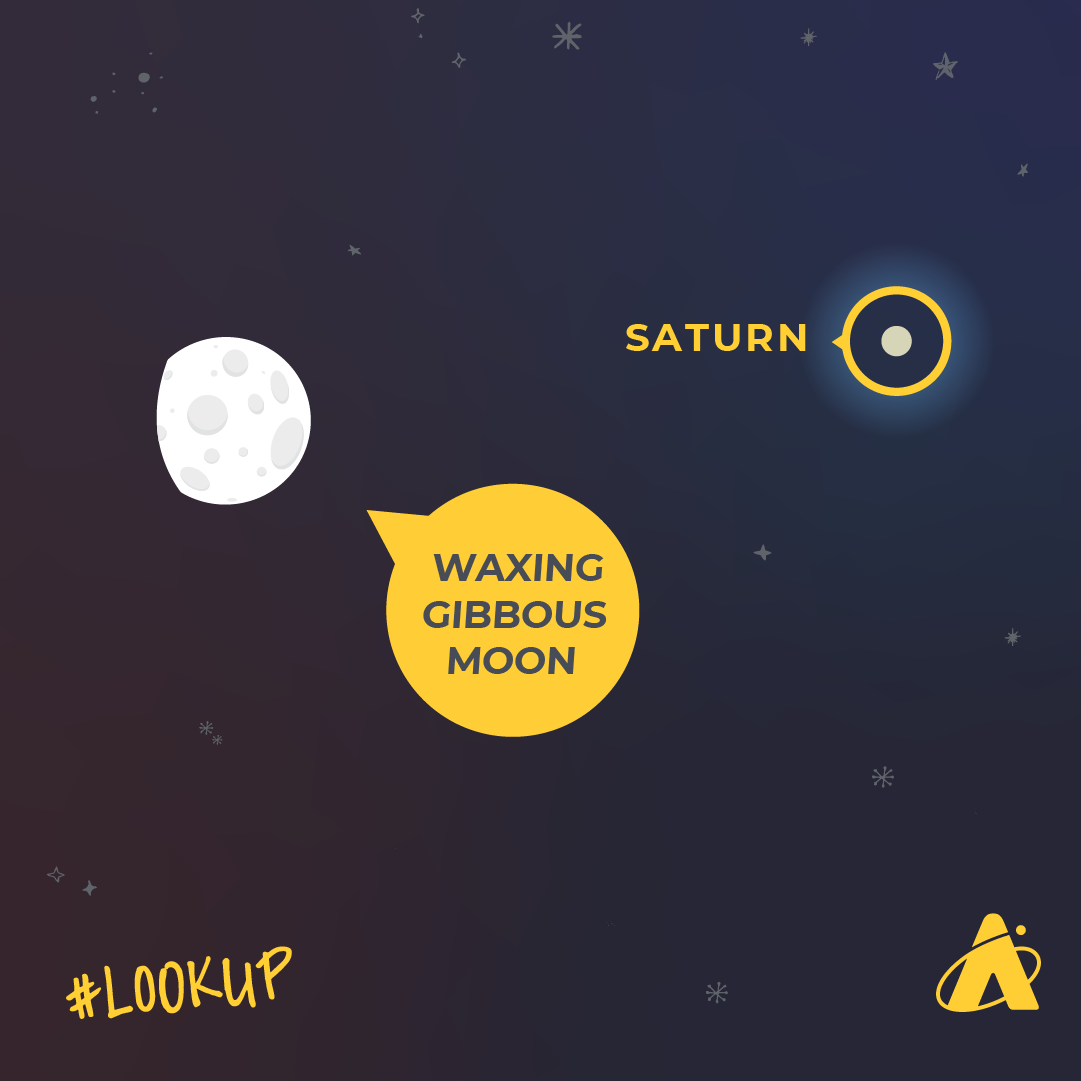
The bright planet Jupiter rises in the east-northeast around 11:00 pm on the first of October and around 9 pm by October 31. Look about ten degrees below Jupiter to see the constellation Orion, the Hunter. It looks like a slightly squashed rectangle of four bright stars, with a small row of three stars across its middle creating his famous belt. But Jupiter outshines them all. After midnight on October 21, a waning gibbous Moon appears near Jupiter. It reaches about 65 degrees high in the southwest sky, when it starts to fade in dawn’s light.
Mars rises in the east-northeast around midnight at the start of the month and closer to 11:00 pm by month’s end. It shines at about magnitude zero. Mars spends the month not far from Pollux and Castor, the brightest stars in the constellation Gemini, the Twins. Mars appears below and to the left of the much-brighter planet Jupiter. The two planets are roughly 25 degrees apart early in the month and move further apart each night. By month’s end, they are nearly 40 degrees apart. In the morning darkness of October 23–24, Mars is near the last-quarter Moon. It gets about 70 degrees high in the southern sky as morning twilight blots it out.
On October 31, you may see a trio of objects in a vertical line in the eastern sky. While Castor, Pollux, and Mars may look like Orion’s belt, the constellation of Orion, the Hunter is actually just to the right of the grouping.
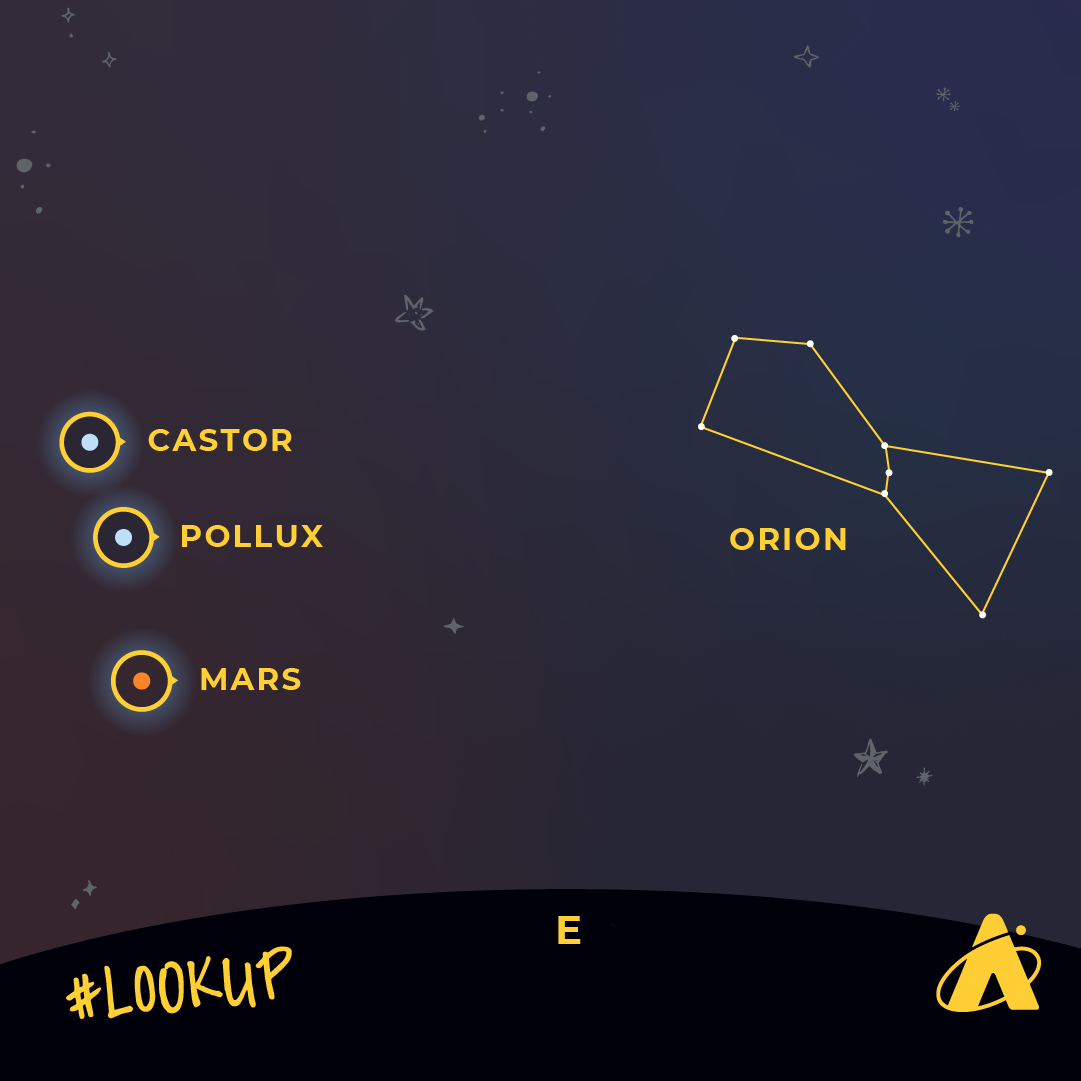
The planet Mercury is mostly hidden in the Sun’s glare this month.
Under extremely clear, dark skies, a human with very good vision can see night-sky objects slightly dimmer than magnitude six brightness. This month, the planet Uranus shines brighter than 5.7 magnitude (the smaller the number, the brighter the magnitude). So theoretically, Uranus may be visible this month, by people with excellent eyesight, in extremely dark, clear skies, far from city lights. It appears about six degrees west of the Pleiades star cluster, which doesn’t get above the eastern horizon this month until about 10:00 pm. If you’re serious about looking for this planet, you’ll want to study a star chart in advance—and maybe use a pair of binoculars.
Moon Phases
New Moon: October 2
First Quarter Moon: October 10
Full Moon: October 17
Last Quarter Moon: October 24
Please note: these descriptions are for the Chicago area, using Central time.
Subscribe To Skywatch Wednesday This October!
Tour the sky with the Adler Planetarium’s Theaters Manager, Nick, in Skywatch Wednesday. Nick uses cutting edge visualizations, NASA images, and astrophotography to show you what you can see in the night sky throughout the year.
Check out Nick’s latest episode for your guide to autumn stargazing! Nick explains how to see five planets and their moons, constellations, and stars that are visible during the fall 2024 season.
Learn From Our Astronomy Educators!
Watch exclusive live episodes of Sky Observers Hangout this October! Learn how to observe upcoming cosmic happenings, enhance your astrophotography skills, and see celestial objects through a telescope virtually with our astronomy educators.
Watch our livestream on October 15, 2024 to learn all about the long-period comet gracing our sky this month. Our astronomy educators Michelle and Hunter will tell you what makes these icy bodies tick and how you can catch a view of this comet before it is propelled back out to the far reaches of the solar system—possibly never to be seen again. Weather permitting, we may show a live view of Comet C/2023 A3 as it sets over Chicago’s skyline.
Adler Skywatch: September 2024
Header Image: Adler Planetarium infographic that reads “HAPPY FALL” in celebration of the autumnal equinox on September 22, 2024. Yellow/orange cartoon leaves create a wreath around the text atop a dark blue background with hand drawn stars. “#LOOK UP” is in the bottom left corner with the Adler Planetarium’s yellow logo in the bottom right corner.
It’s time for the Harvest Moon again—but it’s going to be a slightly different Harvest Moon this September, 2024.
Moons, Equinoxes, And Henges, Oh My!
The full Moon that falls closest to the autumnal equinox is often referred to as the harvest Moon. Usually, this occurs in September, and this month is one of the “usual” years, with the Full Moon on September 17 and the autumnal equinox just five days later. But this year’s Harvest Moon is rather unusual for two reasons.
First, it’s considered by some to be a supermoon, meaning it’s a little closer to the Earth than the Moon usually is. On September 17, the Moon will be about 223,000 miles away. You can compare that to the average distance from Earth to the Moon: about 238,900 miles. Additionally, the harvest Moon this year will be partially eclipsed! But it is important to note that it will not be a spectacular, ruddy-colored total lunar eclipse.
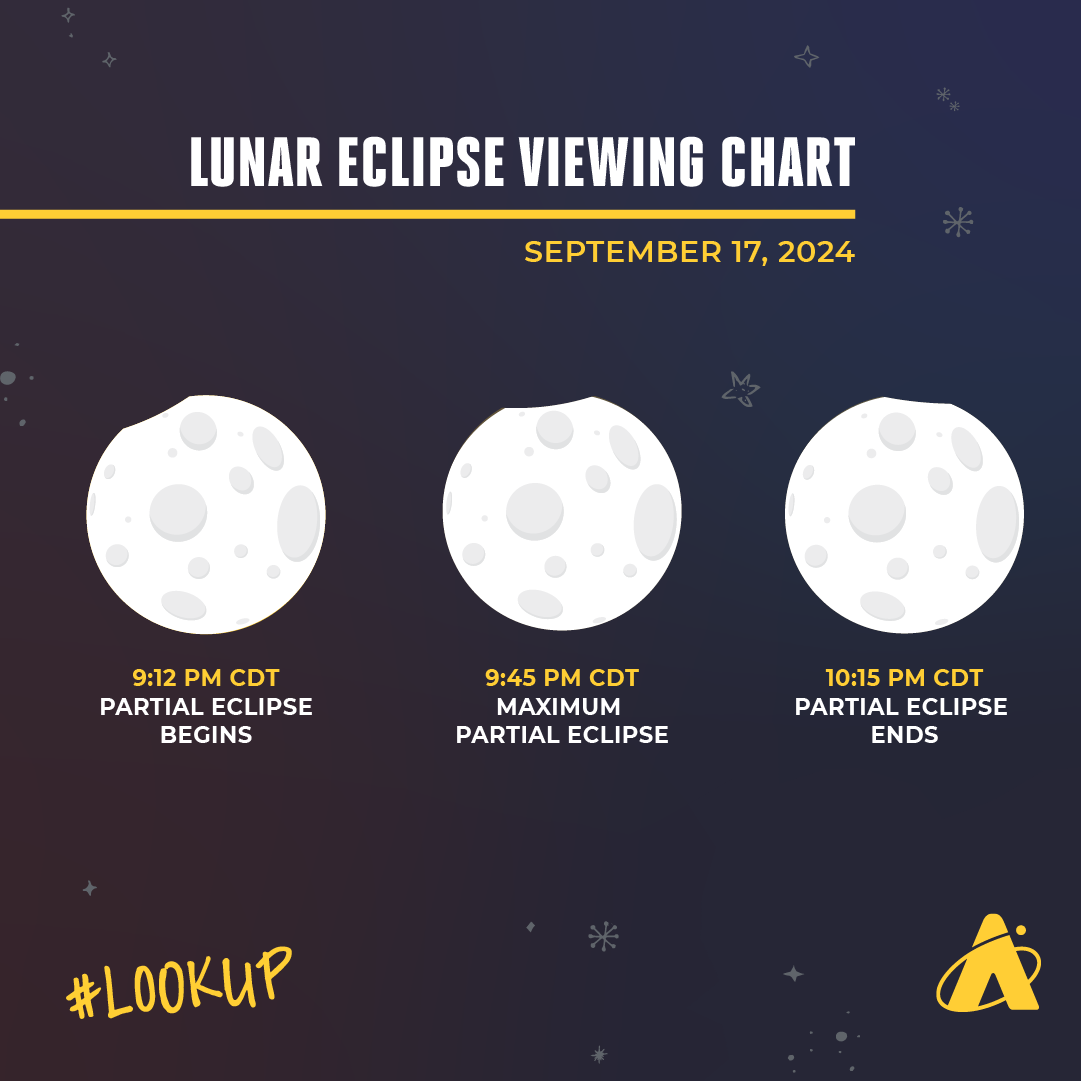
The Earth’s shadow eclipses less than ten percent of the Moon at its maximum during this eclipse. The partial eclipse starts at 9:12 pm CDT, maximum eclipse occurs at about 9:45 pm, and the partial eclipse ends at 10:15 pm. If you’d like to compare eclipse notes with people across the country, join us for our digital program, Sky Observers Hangout, which will focus on this curious super harvest Moon’s partial lunar eclipse!
The autumnal equinox, occurring at 7:44 am on September 22, marks the start of the fall season in the northern hemisphere. The word equinox means equal night—meaning night and day are roughly the same amount of time. The Sun also sets directly east and west on the equinoxes, resulting in the phenomenon known as Chicagohenge. “On the equinox, and for a couple of days before and after, the rising and setting Sun is framed by the canyon-like buildings on either side of Chicago’s east-west running streets.
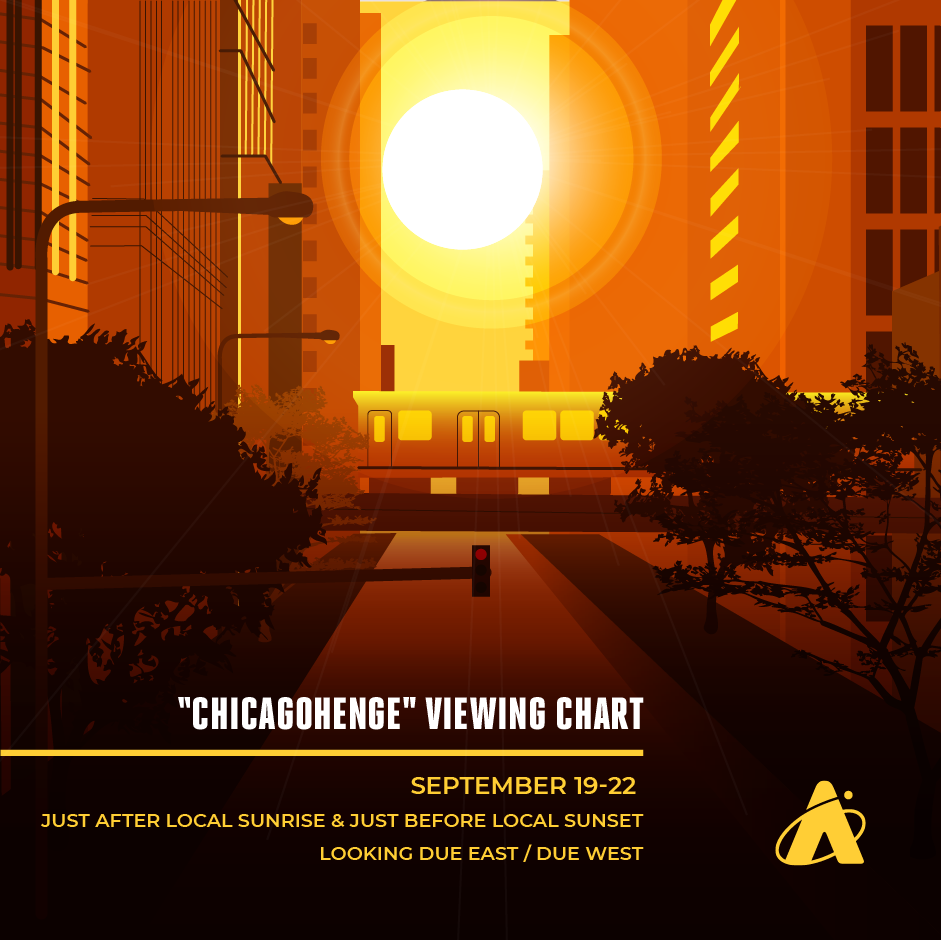
Planet Spotting In September
The brightest planet, Venus, sets shortly after the Sun this month, so it’s not readily visible until it’s very low in the western skies. It’s truly brilliant at roughly -4 magnitude. Setting around an hour after the Sun, it should be visible starting around 30 minutes after sunset. It’s low and close to due-west early in the month and low in the west-southwest later in the month. On September 5, spot Venus near a waxing crescent Moon just after sunset.
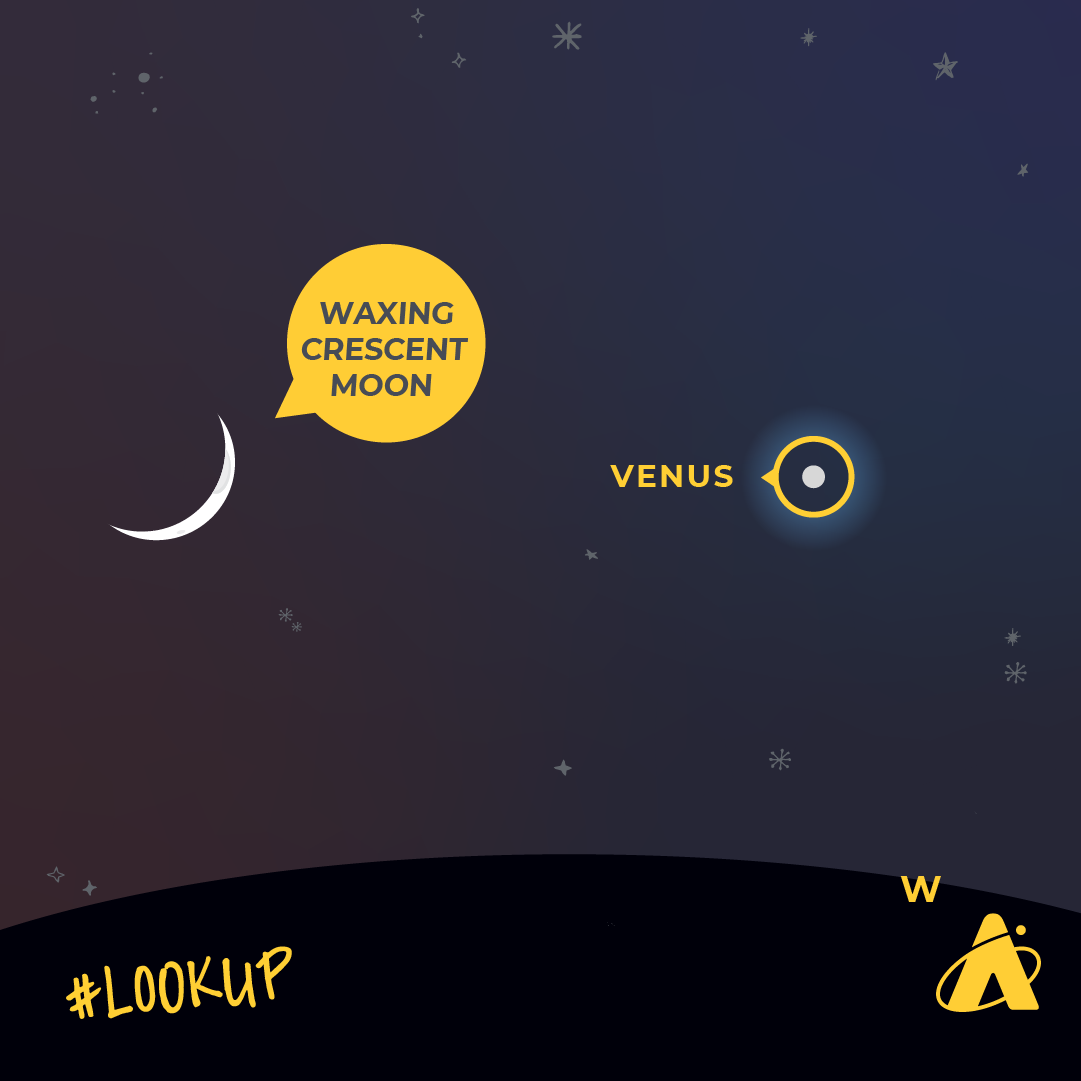
Saturn rises in the southeast near the end of evening twilight this month. It’s slightly brighter than 1st magnitude. The night of September 16 through the early-morning darkness of September 17, Saturn is a few degrees to the left of a nearly full Moon. It reaches about 40 degrees at its highest point in the southern skies each night and sets in the west-southwest during early-morning twilight.
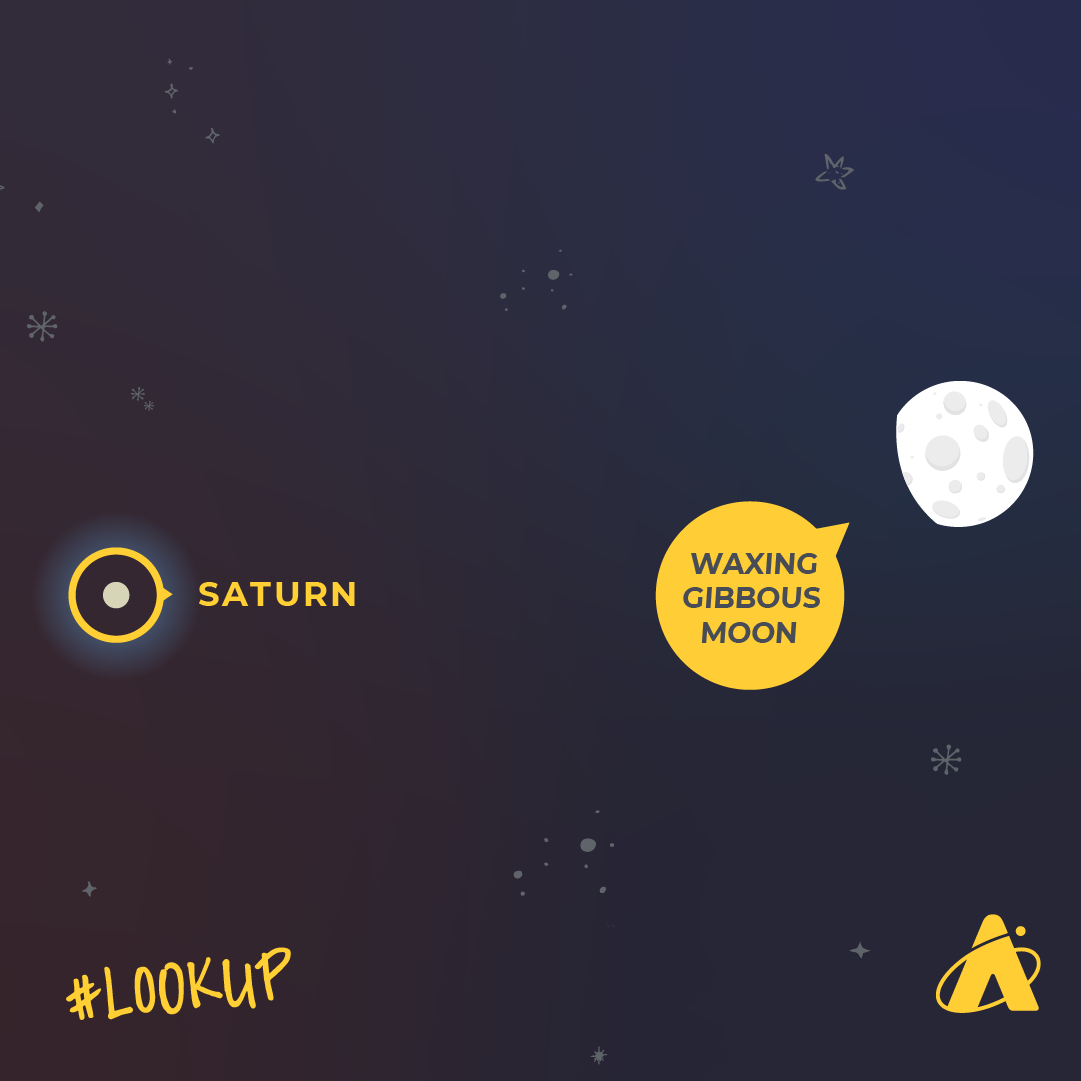
The bright planet Jupiter rises in the east-northeast around midnight at the start of the month and around 10:00 pm by month’s end. It’s brighter than -2 magnitude this month and will continue to brighten slightly every night the next few months, until the first week of December. Very late in the night of September 23 through the early morning darkness of September 24, Jupiter appears near a waning gibbous Moon. Jupiter gets about 70 degrees high in the south at its highest, eventually fading into morning twilight.
The red planet Mars’s brightness varies widely in the night sky. This month, it’s slightly brighter than 1st magnitude. Mars rises in the east-northeast shortly after midnight at the start of the month and shortly before midnight by month’s end. The morning of September 25, look for Mars near a waning crescent Moon. Mars gets about 60 degrees high in the southeast skies until it’s blotted out by the light of morning twilight.
The hard-to-spot planet Mercury may be visible in the predawn skies this month. The first week of the month, look slightly north of east, about ten degrees above the horizon, roughly 45 minutes before sunrise. It gets a little brighter each morning early in the month. By mid-September, Mercury starts moving back closer to the Sun—so close that it will become difficult, if not impossible, to see.
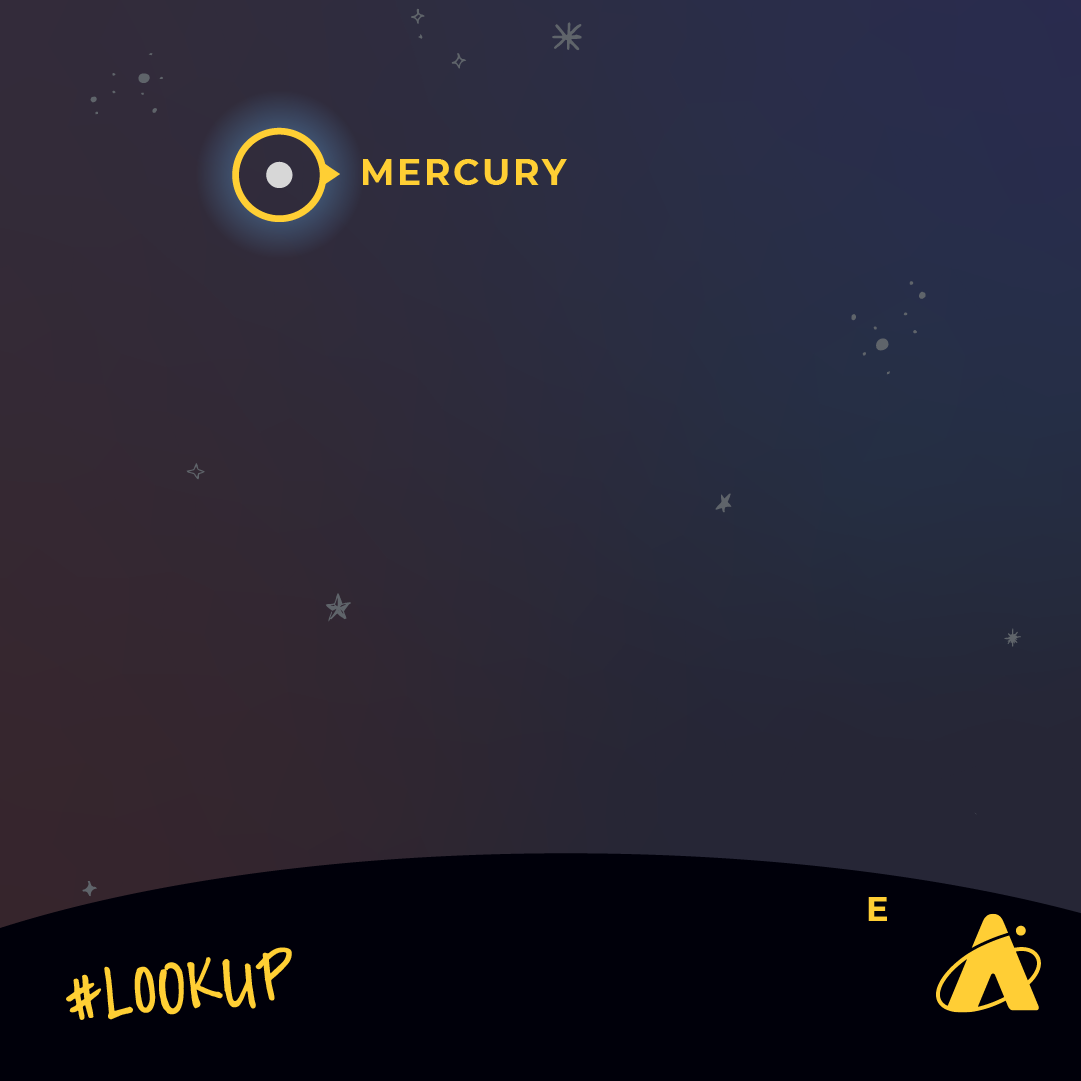
Moon Phases
New Moon: September 2
First Quarter Moon: September 11
Full Moon: September 17
Last Quarter Moon: September 24
Please note: these descriptions are for the Chicago area, using Central time.
Subscribe To Skywatch Wednesday This September!
Tour the sky with the Adler Planetarium’s Theaters Manager, Nick, in Skywatch Wednesday. Nick uses cutting edge visualizations, NASA images, and astrophotography to show you what you can see in the night sky throughout the year.
Check out Nick’s latest episode for your guide to summer stargazing! Nick explains how to see the summer triangle, our galaxy the Milky Way, Saturn, and zodiac constellations. Learn how to see the meteor shower of the summer, the Perseids, and this summer’s full Moons.
Learn From Our Astronomy Educators!
Watch exclusive live episodes of Sky Observers Hangout this September! Learn how to observe upcoming cosmic happenings, enhance your astrophotography skills, and see celestial objects through a telescope virtually with our astronomy educators.
In our latest episode, join our astronomy educators, Michelle and Hunter, to observe globular clusters through our Doane Observatory telescope in this cluster blockbuster! Globular clusters dazzle through telescopes with their tightly packed collections of tens or hundreds of thousands—or even millions—of stars. With some of these stars dating back to the early days of the universe, they give us insights into how stars form and evolve, and how galaxies collide and change.
Adler Skywatch: August 2024
Header Image: A meteor streaks across the sky during the annual Perseid meteor shower, Wednesday, August 11, 2021, in Spruce Knob, West Virginia. Image Credit: NASA/Bill Ingalls
If you like looking for shooting stars, you can wait for a couple of reliable wintertime meteor showers—or you can start looking up this month, August, 2024!
The Perseid Meteor Shower
The Perseid meteor shower is an annual August highlight for night-sky viewers. It’s named for the constellation Perseus, since the meteors appear to radiate from that constellation. Meteors, sometimes called “shooting stars,” do not come from stars, which are many light-years away. Meteors are caused by small rocky or metallic bits of debris, usually from a comet, that burn up in Earth’s atmosphere. Meteor showers occur when Earth runs into a trail of comet debris. In the case of the Perseid meteors, the debris comes from Comet Swift-Tuttle.
To spot meteors, first go outside and give your eyes about 20–30 minutes to adjust to the dark. Look all around the sky for quick streaks of light. These streaks are caused by superheated glowing air as the tiny bits of comet material burn up due to friction with our atmosphere. You don’t need any special viewing tools to see meteors, you won’t see the meteors any better using binoculars or a telescope. Meteors range over a wide expanse of sky, so you don’t want to limit your view to a tiny window.
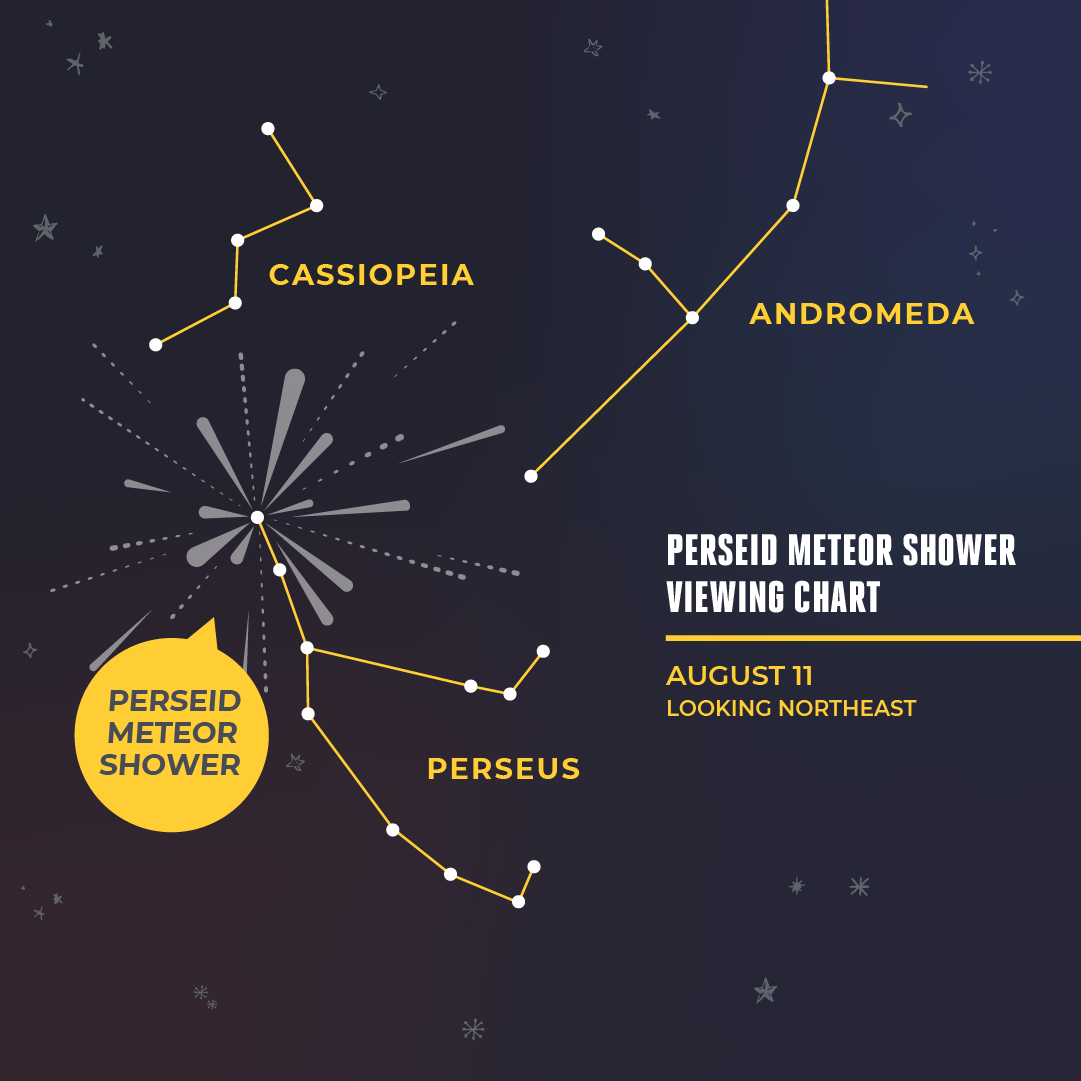
The shower’s peak is expected to fall between midnight and dawn the morning of August 12. One rule of thumb for meteor viewing is to be under a dark sky, with no glare from artificial or natural light (like the Moon). This year, the Perseids peak when the Moon is near its first quarter phase. However, the first quarter Moon rises around noon local time and sets around midnight; so its glare won’t interfere with the Perseids during their peak between midnight and dawn.
Estimates forecast a peak of about 50–90 meteors per hour under very dark, very clear skies. Far fewer meteors will be seen in light-polluted areas. There are other meteor showers that predictably produce the same number of meteors, or more. But those showers occur during the winter. The Perseids take place during the summer, when you won’t be freezing while observing—though you may need some insect repellent.
Planet Spotting This August
The brightest planet, Venus, has spent several months close to the Sun from our perspective on Earth, making it difficult or impossible to view. In August, it starts to move out of the Sun’s glare. Usually, you need to wait until about 40 minutes after the Sun has set to see night-sky objects near the Sun. But at nearly -4 magnitude, you may be able to see Venus earlier in evening twilight once the Sun has completely set. Do not look before then, because looking at the Sun could cause permanent eye damage.
Look for Venus very close to the western horizon. It gets a little easier later in the month, as Venus moves southward each evening and further away laterally from the Sun.
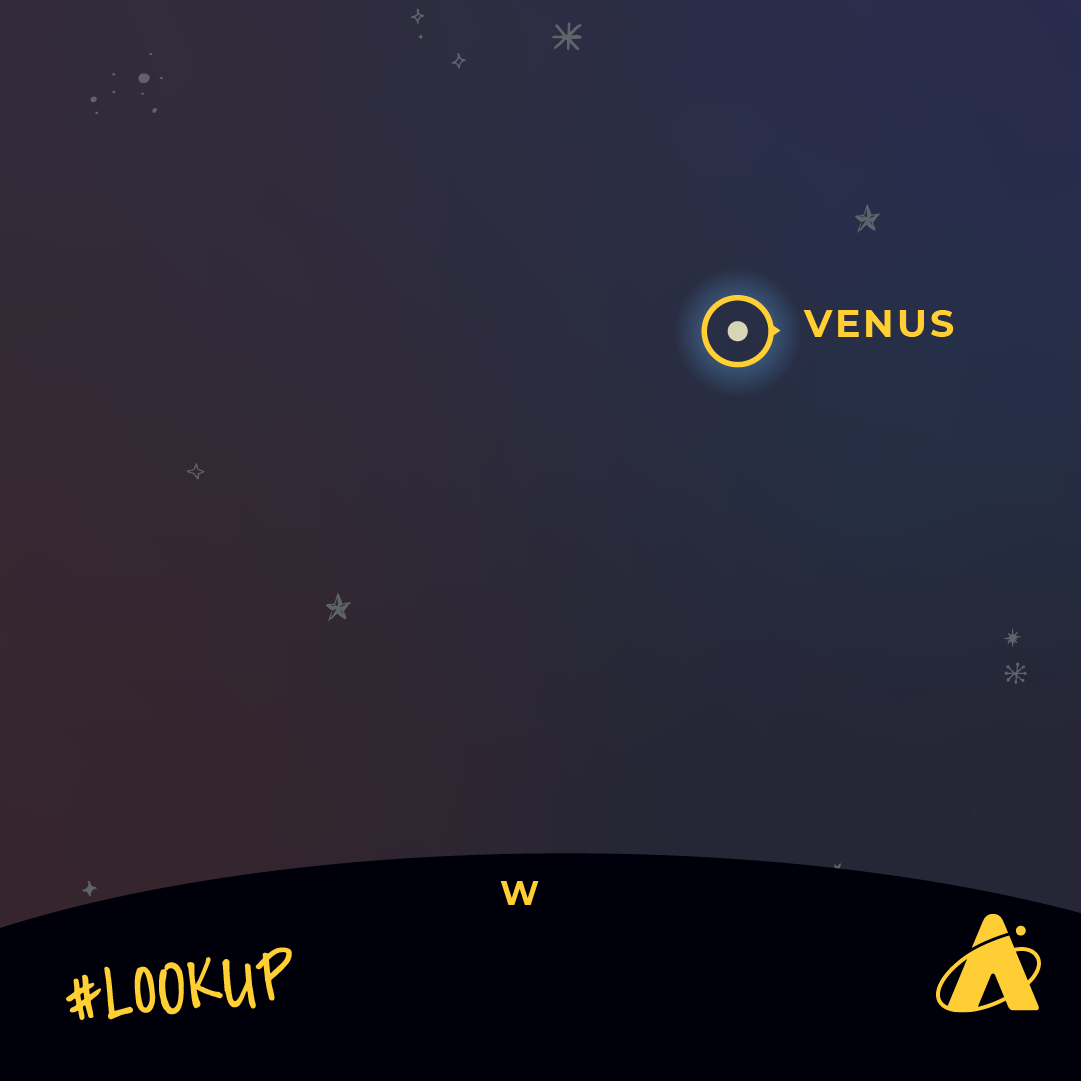
Mercury spends most of this month hidden in the Sun’s glare. But if you have a clear view to the east-northeast horizon, you may be able to spot it about 40 minutes before sunrise on August 30–31. Mercury is slightly brighter than magnitude 1 on these dates. It continues to get brighter and further from the Sun the first few days of next month as well.
The planet Jupiter shines brightly at about -2 magnitude this month. It rises in the east-northeast around 1:30 am Central time at the start of the month, and around midnight by month’s end. Not far from Jupiter this month is the planet Mars, shining at about magnitude 1. Mars starts the month slightly above and to the right of Jupiter in the sky. From August 13–16, the two planets appear to be less than a degree apart.
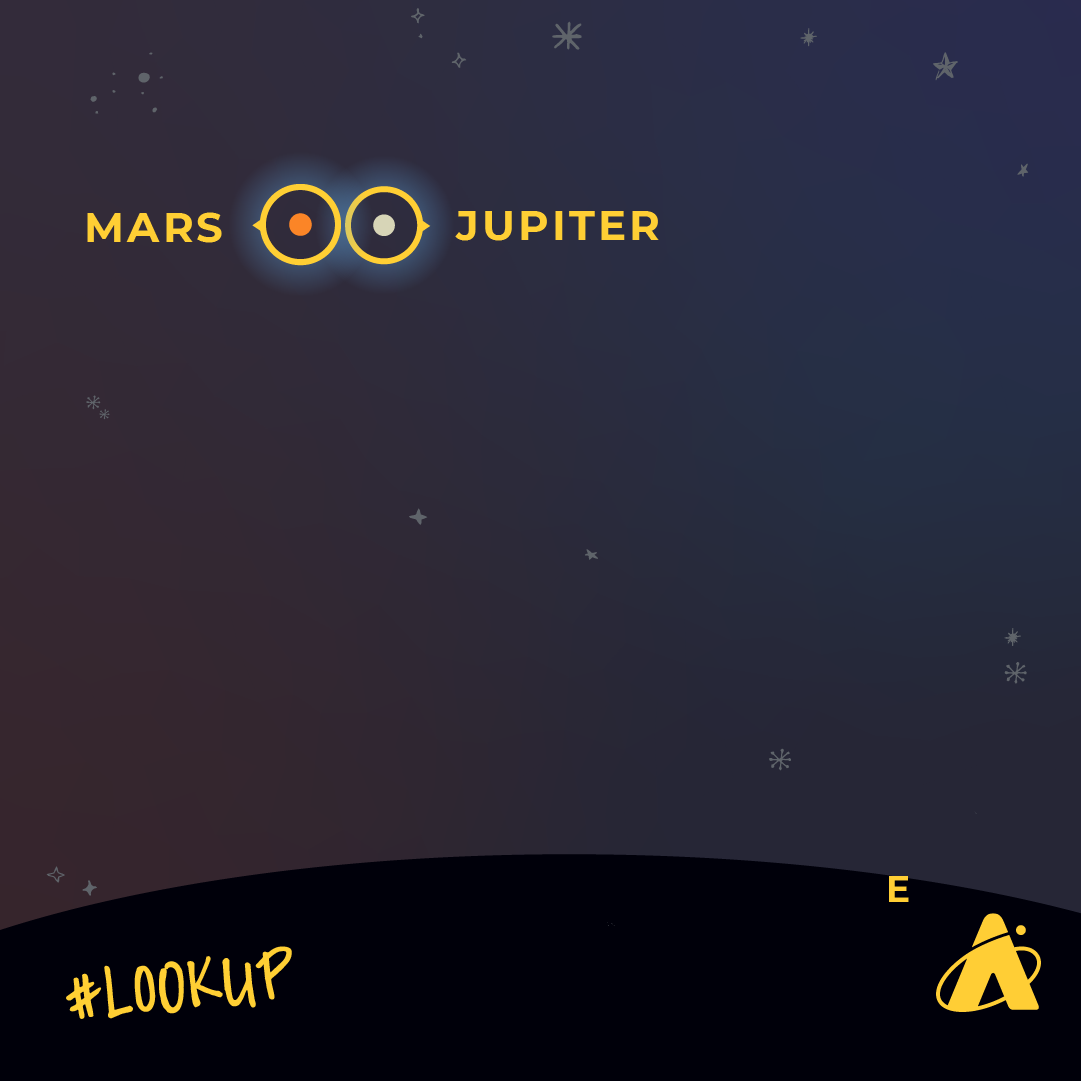
As those mornings pass, Mars appears to move from above Jupiter to below it. Mars continues to move further below Jupiter each morning, so that by month’s end it appears about eight degrees below and to the left of the gas giant. The morning of August 27, a waning crescent Moon hovers above both planets. When the stars begin to fade into dawn’s light, Jupiter and Mars are about halfway up in the southeast sky early in the month, and about 60 degrees up in the southeast sky by month’s end.
The planet Saturn rises slightly south of east around 10:00 pm at the start of the month, and around 8:00 pm by month’s end. It’s slightly brighter than magnitude 1, and continues to brighten each night of the month. The night of August 20, Saturn appears less than half a degree away from the edge of a waning gibbous Moon. As the night passes and turns into the morning of August 21, the planet appears to move away from the Moon’s edge. Saturn gets about 40 degrees high in the south at its highest, and fades low in the southwest skies in morning twilight.
Moon Phases

New Moon: August 4
First Quarter Moon: August 12
Seasonal Blue Full Moon: August 19
Last Quarter Moon: August 26
Please note: these descriptions are for the Chicago area, using Central time.
Subscribe To Skywatch Wednesday This August!
Tour the sky with the Adler Planetarium’s Theaters Manager, Nick, in Skywatch Wednesday. Nick uses cutting edge visualizations, NASA images, and astrophotography to show you what you can see in the night sky throughout the year.
Check out Nick’s latest episode for your guide to summer stargazing! Nick explains how to see the summer triangle, our galaxy the Milky Way, Saturn, and zodiac constellations. Learn how to see the meteor shower of the summer, the Perseids, and this summer’s full Moons, including a blue Moon on August 19, 2024!
Learn From Our Astronomy Educators!
Watch exclusive live episodes of Sky Observers Hangout this August! Learn how to observe upcoming cosmic happenings, enhance your astrophotography skills, and see celestial objects through a telescope virtually with our astronomy educators.
In our newest episode, join our astronomy educators, Michelle and Hunter, to observe globular clusters through our Doane Observatory telescope in this cluster blockbuster! Globular clusters dazzle through telescopes with their tightly packed collections of tens or hundreds of thousands—or even millions—of stars. With some of these stars dating back to the early days of the universe, they give us insights into how stars form and evolve, and how galaxies collide and change.
Adler Skywatch: July 2024
Header Image: A silhouette of a person kneeling in front of a telescope aimed at the night sky. The background shows a dark blue night sky with dim stars in the distance.
The Earth will be a million miles further from the Sun than usual this month. But don’t expect things to get cooler in July, 2024!
On average, the Sun is roughly 93 million miles away from Earth. However, Earth’s orbit is not a perfect circle with all points equal from its center. Rather, Earth’s orbit is shaped like an ellipse, so it moves in an oval-shaped path around the Sun.
On aphelion, when Earth is furthest from the Sun for the year, it’s roughly 94 million miles away. This year, aphelion occurs on July 5. Earlier this year on January 2, Earth was at perihelion, or its closest point to the Sun during its orbit. During perihelion, Earth is more than 3 million miles closer to the Sun than it is at aphelion. The fact that Earth is furthest from the Sun during the warmth of July and at its closest in the midst of winter indicates that a 3 million mile difference in distance from the Sun doesn’t affect Earth’s weather.
Planets In The Predawn Sky
After spending the past couple of months mostly hidden in the glare of the Sun, the planet Jupiter is now fairly easy to see in early-morning darkness. It rises in the east-northeast almost two hours before the Sun at the beginning of July, and more than three hours before the Sun by month’s end. It’s brighter than -2 magnitude so it’s very easy to spot, outshining stars that are normally considered to be among the brightest. The morning of July 3, look for Jupiter to the right of a very slim waning crescent Moon. Jupiter fades into the morning twilight low in the east-northeast early in the month. As each morning passes, Jupiter pulls higher in the sky and away from the Sun’s glare. By month’s end, the planet is nearly 40 degrees high in the east before dawn blots it from view.
There’s another planet in the general vicinity of Jupiter this month—it’s just not quite as bright. Mars rises in the east-northeast, shortly after 2:00 am on July 1 and by about 1:30 am by July 31. Mars is slightly brighter than 1st-magnitude this month, and will continue to gradually get brighter through the end of the year. The mornings of July 1 and July 30, Mars appears near a waning crescent Moon. On July 2, you can find the slim waning crescent Moon in between Jupiter and Mars.
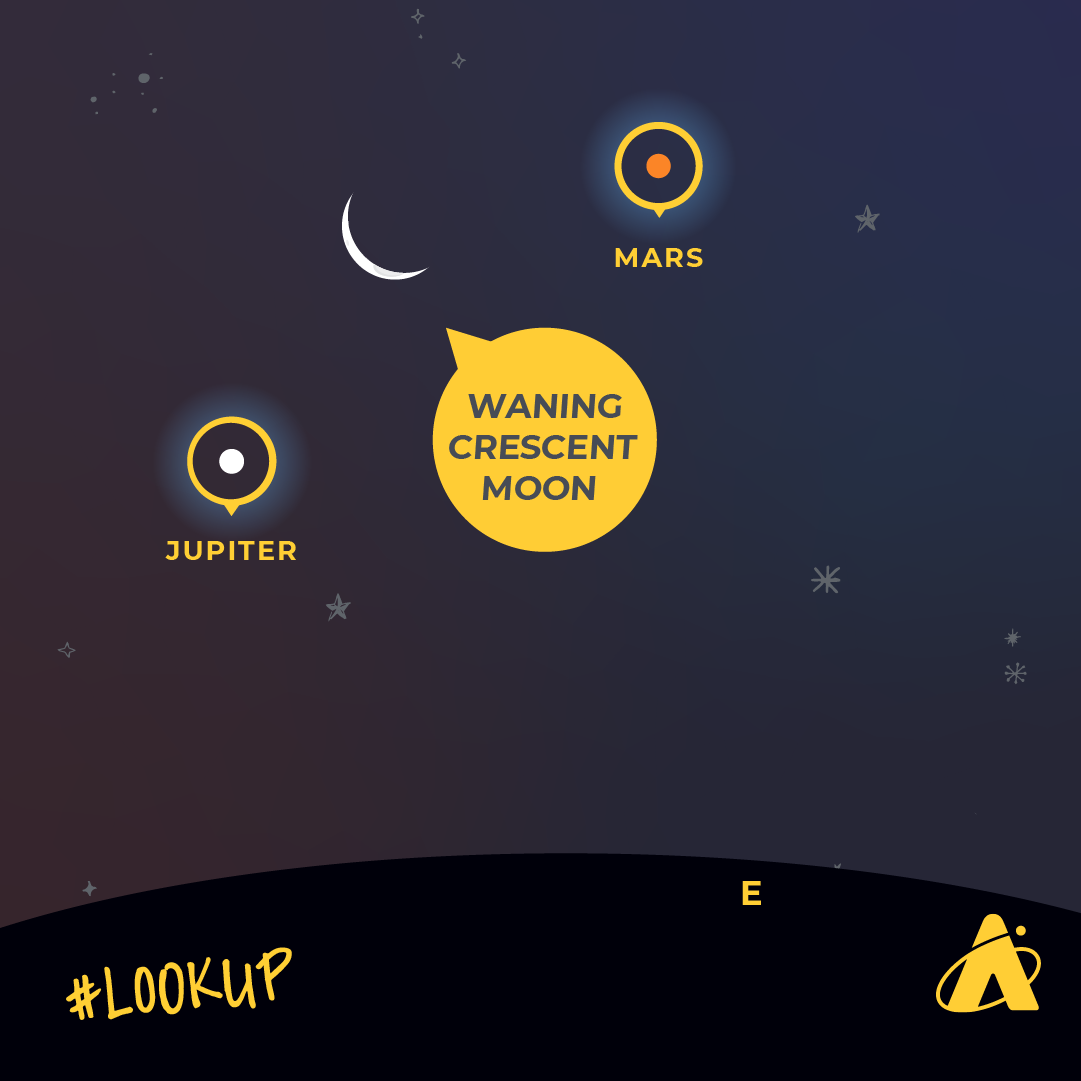
At the start of the month, Mars and Jupiter are about 20 degrees apart in the predawn sky. As the days pass, the two planets appear to move closer together. Compared to the backdrop of stars, Jupiter does not appear to move much. Mars, however, appears to slide down the sky, moving from the constellation Aries towards the constellation Taurus—where Jupiter spends this month. By July 31, the two planets appear only six degrees apart.
Evening Planet Spotting
Turning to the evening skies, Mercury sets about 60–80 minutes after the Sun. If you have a clear view to the west-northwest, try looking barely ten degrees above the horizon about 40 minutes or so after sunset. Your best chance of viewing Mercury is when it appears furthest from the Sun, from about July 11–14. The evening of July 7, a two-day-old crescent Moon is very low in the west-northwest. Mercury appears just below the Moon that evening.
The planet Saturn rises slightly south of east around midnight at the start of the month, and around 10:00 pm by month’s end. It’s around 1st-magnitude in brightness, and brightens very slightly each night of the month. The mornings of July 23–25, Saturn appears not far from a waning gibbous Moon. By the time the rising Sun makes Saturn hard to see, it’s almost 40 degrees high in the southerly skies.
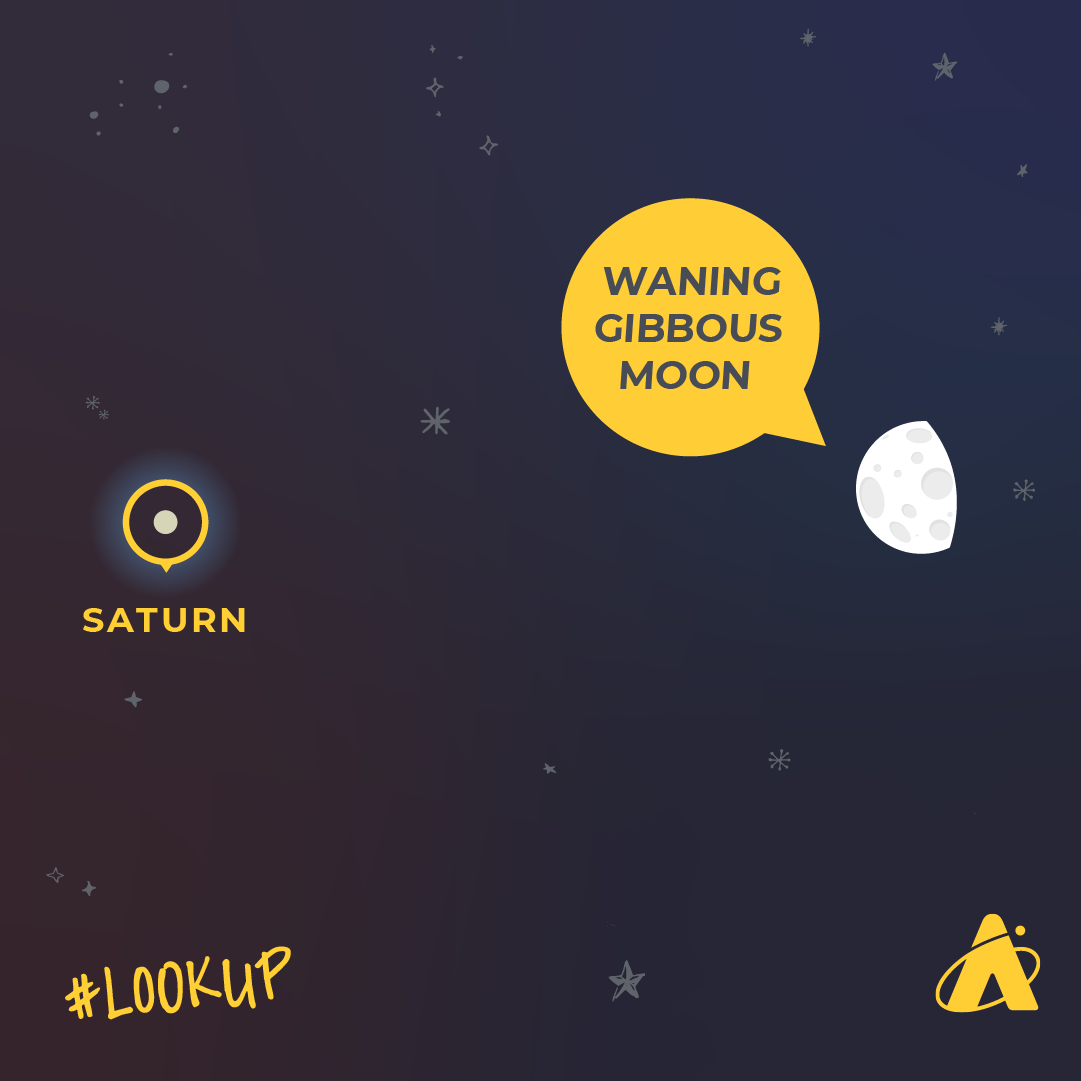
The brightest planet, Venus, spends the month hidden from view in the glare of the Sun.
Moon Phases

New Moon: July 5
First Quarter Moon: July 13
Full Moon: July 21
Last Quarter Moon: July 27
Please note: these descriptions are for the Chicago area, using Central time.
Subscribe To Skywatch Wednesday This July!
Tour the sky with the Adler Planetarium’s Theaters Manager, Nick, in Skywatch Wednesday. Nick uses cutting edge visualizations, NASA images, and astrophotography to show you what you can see in the night sky throughout the year.
Check out Nick’s latest episode for your guide to summer stargazing! Nick explains how to see the summer triangle, our galaxy the Milky Way, Saturn, and zodiac constellations. Learn how to see the meteor shower of the summer, the Perseids, and this summer’s full Moons, including a blue Moon on August 19, 2024!
Learn From Our Astronomy Educators!
Watch exclusive live episodes of Sky Observers Hangout this July! Learn how to observe upcoming cosmic happenings, enhance your astrophotography skills, and see celestial objects through a telescope virtually with our astronomy educators.
In our newest episode, join our astronomy educators, Michelle and Hunter, to observe globular clusters through our Doane Observatory telescope in this cluster blockbuster! Globular clusters dazzle through telescopes with their tightly packed collections of tens or hundreds of thousands—or even millions—of stars! With some of these stars dating back to the early days of the universe, they give us insights into how stars form and evolve, and how galaxies collide and change.
Novas Vs. Supernovas: What’s The Difference?
Header image: In this illustration, a white dwarf star and a red giant star orbit each other, resulting in a nova similar to the T Coronae Borealis nova that is seen every 80 years. Image credit: NASA/Goddard Space Flight Center
Written by Dr. Geza Gyuk, the Adler Planetarium’s Senior Director of Astronomy
Sometime in the summer of 2024, the otherwise unremarkable star T Coronae Borealis, also known as “the Blaze Star,” will flare dramatically. T Coronae Borealis is usually far below naked eye visibility, but for a brief few weeks, it will blaze brightly in our skies, peaking at more than a thousand times its usual brightness! From seemingly nothing, a new star—also known as a “nova”—will be born into our skies, only to fade away into obscurity.
How exactly do these novas form? What about supernovas? And what is the difference between the two? Let’s take a look at these two common types of stellar cataclysms.
Novas Vs. Supernovas
A supernova is much much brighter than a nova. While a nova will typically peak at around 100,000 times the luminosity of the Sun, a supernova is typically billions of times brighter than the Sun!
But the real difference between the two isn’t the brightness, it’s how the brightness is produced. In a nova, a star flares up and then returns to dormancy. In a supernova, the progenitor star is completely destroyed. How does this work?
What Is A Nova?

A nova actually starts as two stars. The first star in the binary is a white dwarf, the dead remnant core of a star like the Sun. A white dwarf has a star’s worth of matter packed into a volume about the size of the Earth. Its gravity is something fierce, not as strong as a black hole or even neutron star, but still a walloping 100,000–300,000 times that of the Earth! It also has a solid surface, unlike the Sun or most other stars which are composed of plasma.
The second, known as a companion star, is a regular star, made of hot incandescent hydrogen plasma. If the white dwarf orbits close enough to its companion star, its powerful gravity can actually steal some of its companion’s matter, pulling the plasma onto its own surface. There, the hydrogen piles up and is heated and squeezed by the white dwarf’s gravity. As the layer of stolen hydrogen gets ever thicker, denser, and hotter, it finally reaches a point where fusion reactions kick in and the hydrogen layer “burns” suddenly and explosively. In just minutes or hours, it may release more energy than the Sun produces in a thousand years! The remaining unburnt hydrogen is thrown out at speeds of more than 1,000 km/s.
As massive and impressive as a nova is, it is not powerful enough to destroy—or even seriously damage—the white dwarf or its companion. And so the process begins again with hydrogen accreted from the companion. For most novae, the time between outbursts will be many years. But for some novae, the time between reoccurrences is short enough that we have historical records of previous outbursts. T Coronae Borealis is one such “recurring nova”. It has a recurrence time of just under 80 years.
What Is A Supernova?
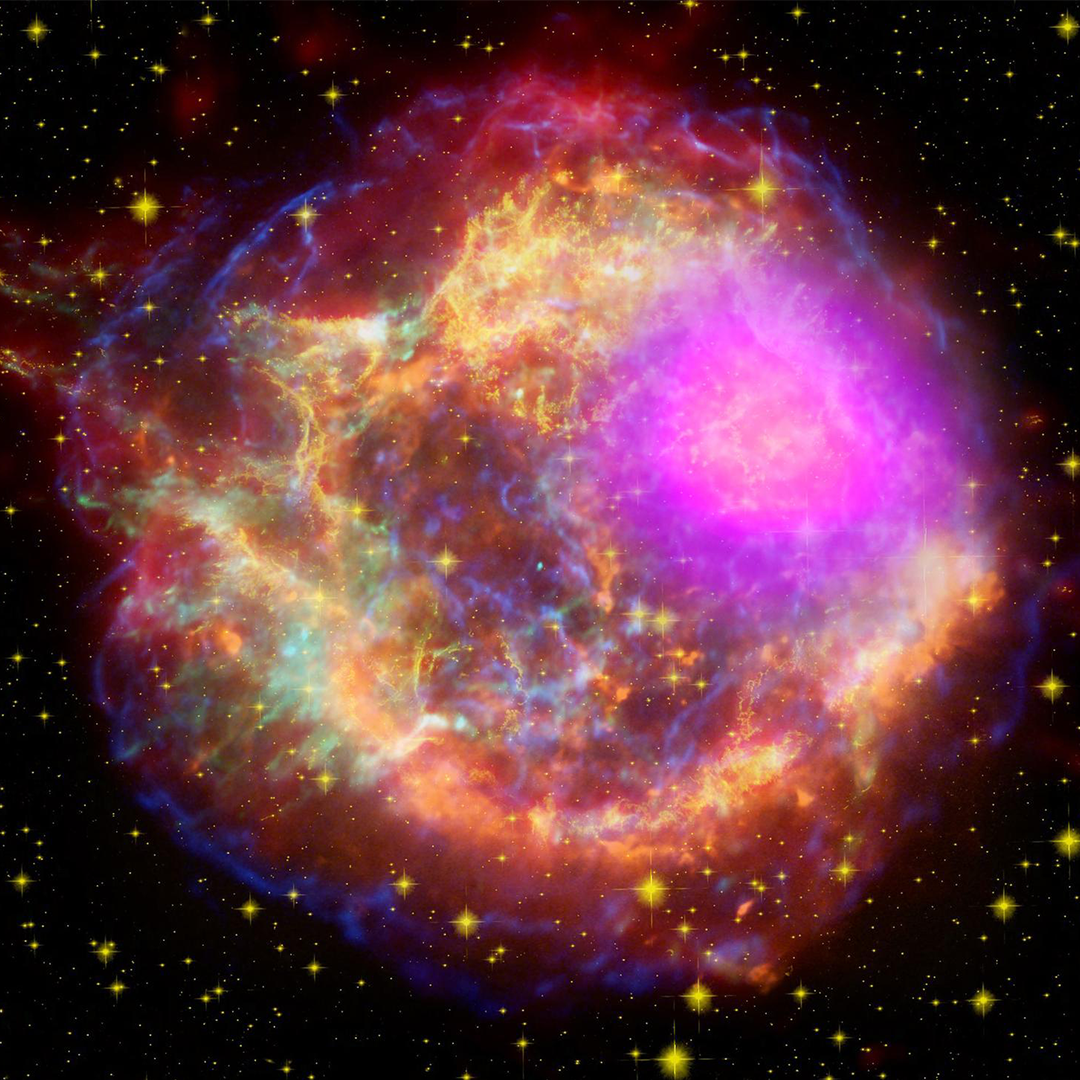
So if that’s a nova, then what powers a supernova? Well, there are two main kinds of supernovae, core collapse supernovae and thermal runaway supernovae. Sounds complicated, but hang on because the ride is wild but worth the trip!
A core collapse supernova is basically powered by gravity. That may not sound very impressive, but that’s because our experiences of gravity are based on small masses for small distances in small gravitational fields. If you drop a penny here on the Earth, it is a pretty forgettable event. But if you drop a watermelon from the top of a skyscraper, then we begin to see a hint of gravity’s power. Now, imagine you drop a watermelon from a skyscraper under a gravity a trillion times stronger than Earth’s…you’d expect a pretty powerful result when that watermelon hits the ground. In fact, the explosion would be equivalent to a 5 megaton bomb! The core of a star is much much more massive than a watermelon. And it is much bigger than a skyscraper. Put these things together and you have the recipe for something spectacular!
At the end of its life, the core of a massive star suddenly runs out of fuel. Without fuel for nuclear fusion, it can no longer support itself against its tremendous gravity—so it collapses. The most massive stars will collapse directly into a black hole. All that energy of the collapse simply gets swallowed up into the black hole and that’s that. But for stars of just the right mass, the core forms an absurdly dense and solid neutron star.
The neutron star serves as the “ground” off of which the falling mass can bounce, releasing its energy. The process of forming the neutron star actually releases the vast majority of the energy as a sudden fast burst of neutrinos which fly out of the doomed star. But the 1% that is left is enough to tear the star to bits, blowing the outer layers into space at speeds up to a few percent of the speed of light. That’s a supernova. Well, a type II, core collapse supernova, at any rate.
You’d think that nature would be satisfied with core collapse supernovae. But insanely, nature has figured out another way to make stars explode with absurd violence: thermal runaway supernovae.
Thermal runaway supernovae, also called Type Ia supernovae, are like a massively scaled up version of a regular nova. It starts with a white dwarf, which, in one way or another, increases in mass. A white dwarf is composed of carbon and oxygen atoms and the usual conditions inside a white dwarf cannot ignite nuclear fusion in these atoms. With no source of energy, the white dwarf just sits there, slowly cooling, radiating energy away as heat. But if the mass increases, then the pressure and temperature inside can grow due to the increased gravity and eventually it can reach a critical point. Deep within the core of the white dwarf, the sleeping dragon of fusion re-ignites.
Normally this wouldn’t be too terribly impressive. The fusion would produce a bit of heat, the heat would produce pressure, and the pressure would expand the star—lowering the temperature and the fusion rates would go down. The process would regulate itself. But the matter of a white dwarf is different.
In a white dwarf, the matter is degenerate—meaning an increase in temperature does NOT lead to increased pressure. So the white dwarf can’t expand and therefore, it can’t reduce the temperature. So more fusion leads to higher temperature, which leads to even more fusion, and so on. A runaway occurs and, in just a couple seconds, the entire white dwarf is consumed by a nuclear conflagration, raising temperatures to billions of degrees. The white dwarf is completely blown apart, with the debris racing outwards at velocities up to 6% of the speed of light.
The fundamental difference between a nova and a type Ia supernova is that the nuclear burning in a nova is hydrogen fusion and it happens in a layer on the surface. Only a tiny fraction of the mass of the star is burned, and so it lives to nova another day. In fact, it may be the case that over time, all nova recur and rebuild their mass, with each nova eruption leaving a deposit of ash on the white dwarf. Eventually many repeated novae may give birth to a supernova!
Learn More About T Coronae Borealis
With all the specifics of novas and supernovas now in your back pocket, learn about the upcoming nova that will brighten our skies this summer, T Coronae Borealis!
Join Experts At The Museum To Talk All Things Astronomy!
Do you have more questions about novas, supernovas, other stellar cataclysms, or anything else astronomy-related? Join us at the Adler Planetarium every Wednesday and Saturday for Astronomy Conversations! In Astronomy Conversations, visiting astronomers talk all things astronomy in an informal Q&A setting, paired with interactive space visualization experiences.
Learn more and see this month’s visiting experts!
Learn From Our Astronomy Educators!
Learn more about astronomy and the night sky in live episodes of Sky Observers Hangout! Learn how to observe upcoming cosmic happenings, enhance your astrophotography skills, and see celestial objects through a telescope virtually with our astronomy educators.
In their latest episode, our astronomy educators observe globular clusters through our Doane Observatory telescope in this cluster blockbuster! Globular clusters dazzle through telescopes with their tightly packed collections of thousands—or even millions—of stars. With some of these stars dating back to the early days of the universe, they give us insights into how stars form and evolve, and how galaxies collide and change.
How To Get To The Adler Planetarium And Museum Campus During The 2024 NASCAR Chicago Street Races
Header Image: The Adler Planetarium on a sunny, summer day, with a line of guests on the museum steps. The planetarium’s iconic dome is seen in front of a vibrant blue sky.
Warm breezes, solar observing opportunities, and the sound of engines revving can only mean one thing: NASCAR Chicago Street Races are back!
If you couldn’t snag tickets for the races, you’re probably still looking for an exciting way to celebrate Independence Day weekend. If so, then you’re in luck, because the Adler Planetarium will be open to the public during the races, on July 6–7, 2024.
Transportation in downtown Chicago might be a little tough while NASCAR takes over some of our streets. The races will only take place over the holiday weekend however, the set up and tear down will take a little longer. Beginning June 10, 2024, many roads will be partially or fully closed to the public, including the roads near Museum Campus. But fear not, we’re here to help!
Whether you’re a local or a tourist, here is the ultimate guide to navigating to Museum Campus during the 2024 NASCAR Chicago Street Races. We’ll explain the best ways for you to get to the Adler Planetarium, Field Museum, Shedd Aquarium, Northerly Island, and Soldier Field whether you’re driving, walking, biking, or taking public transportation.
Taking Public Transportation

Chicago has one of the best public transportation systems in the country. It is a simple, safe, and convenient way to get around the city. Especially during NASCAR, the Chicago Transit Authority (CTA) will be the best way to get to the Adler Planetarium.
Roosevelt Station is the closest “L” stop to the Museum Campus (if you’re not from Chicago, the “L” is our affectionate nickname for our train system). Roosevelt Station—located on Roosevelt and State— is a convenient hub for the Red, Orange, and Green train lines. So regardless if you’re coming from the north, south, west, or southwest, Roosevelt will be your stop!
After getting off at Roosevelt, hop on the #146 shuttle that will run from Roosevelt Station to the Museum Campus during the #146’s normal hours, using an alternate route (pictured below). Exit the bus at the Adler Planetarium, and voila! Enjoy your space adventure.
For live updates on where your train or bus is, check out the CTA schedule here.

From Ogilvie Transportation Center and Chicago Union Station
If you’re visiting the museum from outside of the city, the Metra Metropolitan Rail is a great way to get to the city without a car!
If you arrive in Chicago at Ogilvie Transportation Center, walk east on Madison and take the Brown line at Washington/Wells towards Kimball.
If you arrive in Chicago at Union Station, walk east on Adams and take the Brown line at Quincy towards Kimball.
- Exit the Brown line at Harold Washington Library-State
- Walk one block east to State and Van Buren, take the southbound #146
- Exit at Solidarity Drive and Planetarium
Note: The #146 buses will terminate at Roosevelt Station during the races. The CTA will operate a #146 shuttle bus between Roosevelt Station and Museum Campus during regular #146 hours of service.
Walking/Biking

For those who are venturing on foot or bicycle, the Lakefront Trail will be open and is certainly the most scenic route to the planetarium. If you’re coming from the north or south, this is the route you’ll want to take.
Alternatively, if you’re coming from the west, take a trek through Arvey Field, entering from Columbus, just north of Roosevelt Road. Stroll east through the park and Museum Campus, and you’ll see our iconic copper dome on the horizon!
If you’re looking for a bike share, there are Divvy stations all over Chicago, including one right outside the Adler Planetarium! Find Divvy bike stations in Chicago here.

Water Taxi

Feeling adventurous? Taking a water taxi may be the most exciting—and traffic-free—route to the Adler Planetarium. Shoreline Sightseeing offers a scenic boat ride from Navy Pier to the Museum Campus, stopping at the iconic Buckingham Fountain along the way!
Taking a water taxi to the planetarium is great for tourists who want to get a taste of Lake Michigan, as well as locals who are looking for a fun way to see our beautiful city! Once exiting the boat, the Adler Planetarium is just a short walk away. Learn more about taking a water taxi to the Museum Campus here.

Driving

Driving, though a convenient and private form of transportation, will likely be the most difficult route to the Adler during the NASCAR races. Many of the roads surrounding Museum Campus will be used in the race. However, if you prefer driving, there are still options!
- If you’re driving from the north
- Hop on I-90 E/ 94 E. I-90 brings you into downtown Chicago from the northwest suburbs, while I-94 brings you in from the northern suburbs of Chicago.
- Take exit 53 to US-41 N/S DuSable Lake Shore Drive/ US Highway 41 N
- Take the US-41/ N DuSable Lake Shore Drive exit from the I-55/Stevenson Expressway
- Continue north on DuSable Lake Shore Drive
- Exit at 18th Street
- Continue onto Special Olympics Drive
- Turn right on Solidarity Drive and continue east to arrive at the Adler Planetarium

- If you’re driving from the from the south
- Route B: Take I-90 or I-94. I-90 follows more closely along the lakefront of Lake Michigan, while I-94 brings you into Chicago from a little further south. The two converge around 66th Street, so if you’re coming from north of 66th, don’t worry about which to take.
- Head toward 22nd Street
- At Exit 53C, head on the ramp for I-55 North toward DuSable Lake Shore Drive
- Continue north on DuSable Lake Shore Drive
- Exit at 18th Street
- Route C: If it’s easier to access DuSable Lake Shore Drive rather than I-90/I-94, you can take it northbound instead.
- Exit at 31st Street, then proceed north on Fort Dearborn to 18th Street
- For both Route B and C: After exiting at 18th Street, continue onto Special Olympics Drive
- Turn right on Solidarity Drive and continue east to arrive at the Adler Planetarium

- If you’re driving from the from the west
- Use Eisenhower Expressway I-290 E towards S Wells Street
- Take the ramp for I-90/ I-94 E towards Indiana
- Take Exit 53 to US-41 N/S DuSable Lake Shore Drive/ US Highway 41 N to get onto I-55 N/ Stevenson Expressway
- Take the US-41 N/S DuSable Lake Shore Drive exit
- Continue on US- 41 N/ DuSable Lake Shore Drive
- Exit at 18th Street
- Continue onto Special Olympics Drive
- Turn right on Solidarity Drive and continue east to arrive at the Adler Planetarium

If you do plan on driving, please note that parking on Museum Campus may be limited. The Adler Planetarium does not own the parking lot near the museum.
Regardless of how you choose to travel to the Planetarium, remember that tickets must be purchased in advance of your visit.
During your visit, be sure to catch these 10 things you won’t want to miss at the Adler Planetarium. And don’t forget to take a look at our sky show offerings! (PS Pink Floyd’s space show, The Dark Side Of The Moon, is still playing at the Adler for a limited time!)
We can’t wait to explore the universe with you!
Adler Skywatch: June 2024
Header Image: A cartoon Sun with sunglasses is hugging a smiling cartoon Earth in an Adler Planetarium infographic celebrating the 2024 summer solstice.
The northern hemisphere’s longest day of the year takes place this month, June 2024, with the summer solstice.
When Is The Summer Solstice
The summer solstice occurs on June 20, at 3:51 pm Central Daylight time (CDT). Our solstices are caused by the slight tilt in Earth’s axis in relation to the plane of its orbit. This tilt is about 23.5 degrees off-vertical. As a result, when Earth circles the Sun each year, a different half of the globe is leaning slightly towards or away from the Sun. The summer solstice occurs in the northern hemisphere when the northern half of the globe has its closest tilt towards the Sun of the year. Conversely, it’s also when the southern hemisphere experiences the winter solstice, as the southern half of the globe is at its furthest tilt away from the Sun.
As the summer solstice approaches, the amount of daylight increases each day while the nights get shorter. After the summer solstice, the amount of daylight gradually diminishes each day, until the winter solstice—which falls on December 21 this year.
How To See The Planets This Month
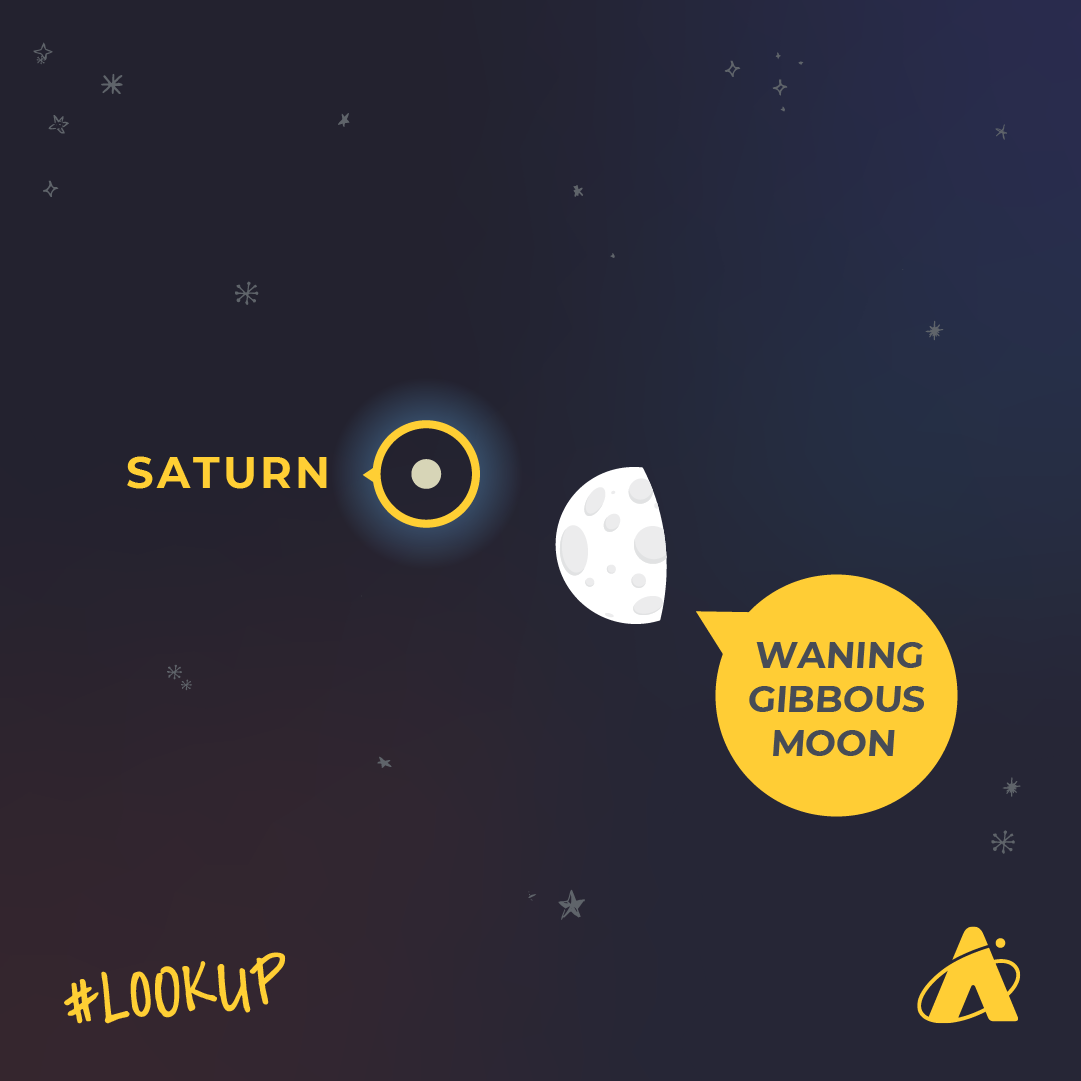
Most of the planetary action this month occurs before dawn. Saturn rises a little south of east around 2:00 am at the start of the month, and around midnight by month’s end. It’s slightly dimmer than first-magnitude brightness this month, so it’s not difficult to see. The morning of June 27, Saturn appears about three degrees to the left of a waning gibbous Moon. Saturn gets about 30 degrees high in the southeast skies before it fades in morning twilight.
Mars rises a little north of east around 3:30 am at the start of the month, and around 2:30 am by month’s end. Mars is shining around first-magnitude and will be easy to spot in June. The morning of June 2, the planet is about six degrees below and to the left of a waning crescent Moon. The next morning, June 3, the planet appears slightly below and to the right of the waning crescent Moon. Mars gets about 15–20 degrees above the eastern horizon before dawn’s glare blots it from view.
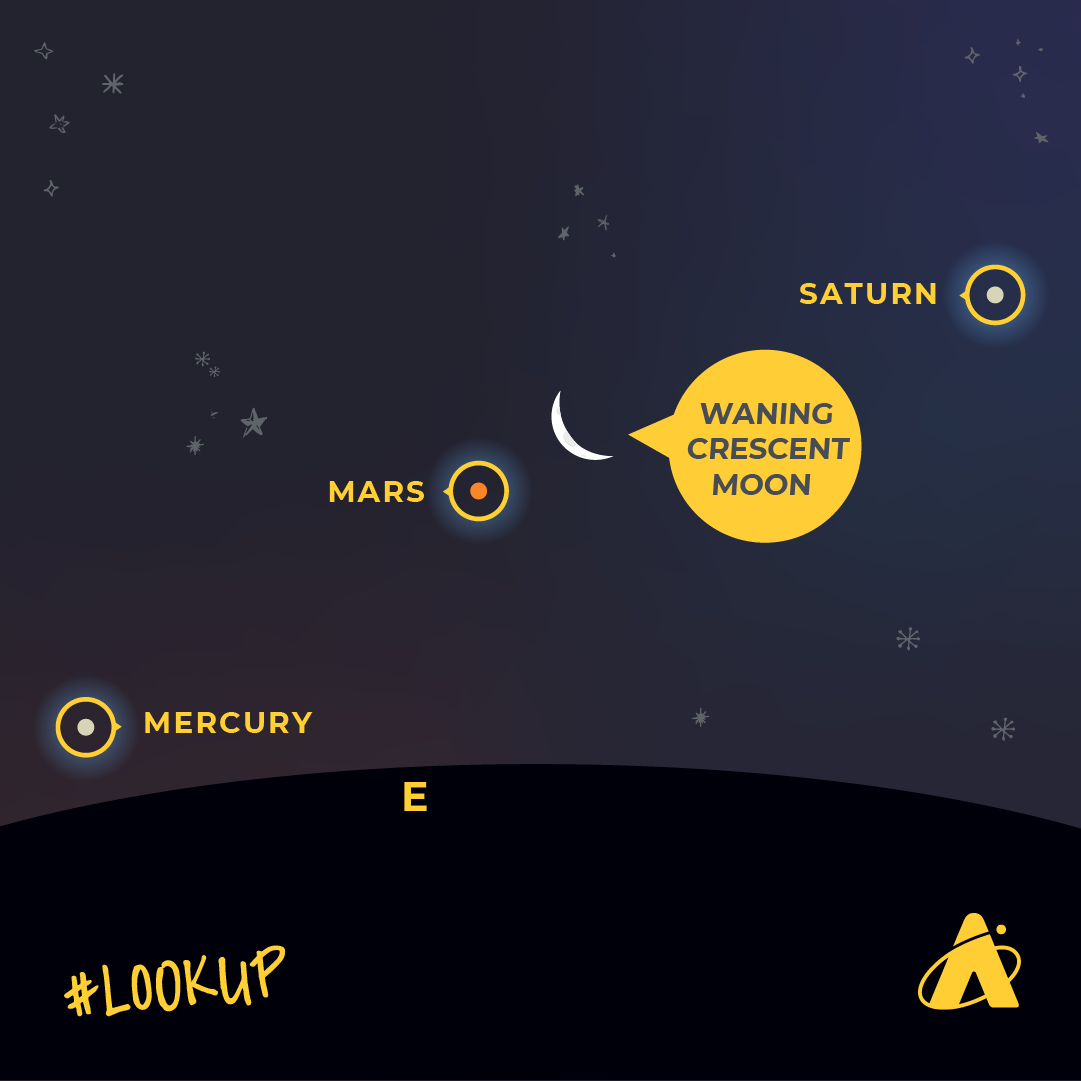
The last week of the month, those with a clear view to the east-northeast horizon may be able to glimpse the bright planet Jupiter briefly before sunrise. At minus-two magnitude, Jupiter outshines everything in the night sky except the Moon and certain satellites. Look for it about ten degrees above the horizon about an hour before sunrise. It fades from view as dawn breaks (and viewers should stop looking for it before the Sun rises). Next month, Jupiter rises earlier and gets slightly higher in the east-northeast as the days pass—making it easier to see before dawn.
The one planet that may be visible in the evening this month is Mercury—but the window of viewing will be brief. You may be able to see it on June 29–30, as it sets about an hour after the Sun those evenings. Those days, try looking for it about 40 minutes after sunset, several degrees above the west-northwest horizon. You’ll likely need a clear view to the horizon to see it.
This month the brightest planet, Venus, appears too close to the Sun to be readily observable.
Moon Phases
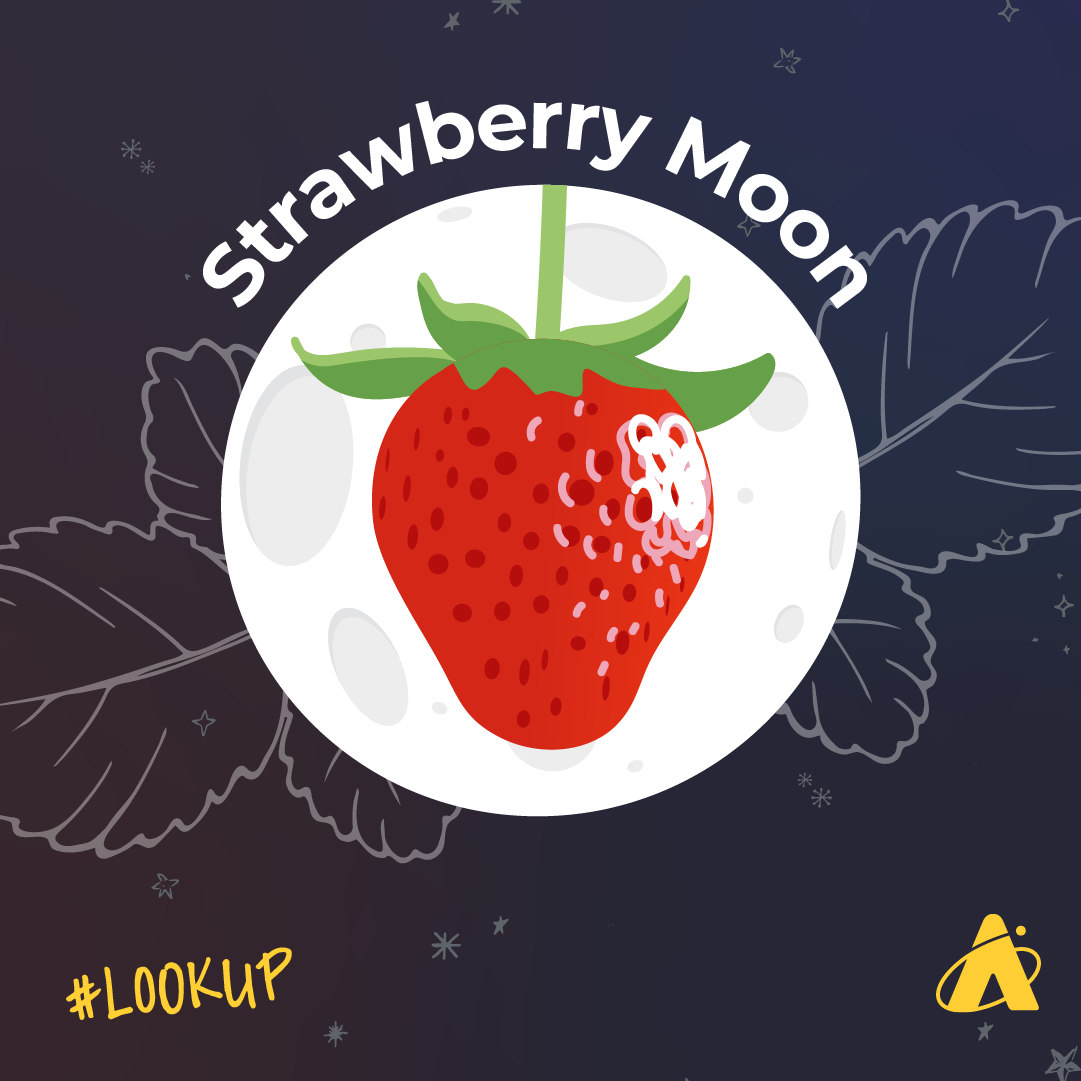
New Moon: June 6
First Quarter Moon: June 14
Full Moon: June 21
Last Quarter Moon: June 28
Please note: these descriptions are for the Chicago area, using Central time.
Subscribe To Skywatch Wednesday This June!
Tour the sky with the Adler Planetarium’s Theaters Manager, Nick, in Skywatch Wednesday. Nick uses cutting edge visualizations, NASA images, and astrophotography to show you what you can see in the night sky throughout the year.
Check out Nick’s latest episode for your ultimate guide to spring stargazing and the April solar eclipse! Don’t miss your chance to see Orion the Hunter and learn how to find constellations like Leo, Ursa Major, Boötes, and Virgo; and so much more!
Learn From Our Astronomy Educators!
Watch exclusive live episodes of Sky Observers Hangout this June! Learn how to observe upcoming cosmic happenings, enhance your astrophotography skills, and see celestial objects through a telescope virtually with our astronomy educators.
Join our astronomy educators, Michelle and Hunter, to observe globular clusters through our Doane Observatory telescope in this cluster blockbuster! Globular clusters dazzle through telescopes with their tightly packed collections of tens or hundreds of thousands—or even millions—of stars. With some of these stars dating back to the early days of the universe, they give us insights into how stars form and evolve, and how galaxies collide and change.
What Are Gravitational Waves And How They Helped Us Discover The “Mass Gap” Black Hole
Header Image: Artistic rendition of a black hole merging with a neutron star. Image credit: LIGO-India/ Soheb Mandhai
Written by The Adler Planetarium’s Astronomer, Dr. Michael Zevin.
Humanity’s understanding of the universe has evolved in parallel with new methods of observing the cosmos. Our ancient ancestors tracked and cataloged the motion of heavenly bodies, and by the early 17th century, the invention of the telescope allowed us to observe dimmer, more distant objects. In the 19th century, we began relying on astronomical photography—which allows us to expose images of the universe for longer periods of time—and astronomical spectroscopy—which breaks apart light into its constituent colors.
By the 20th century, we could observe the universe in energies and colors of light that the human eye cannot see and we finally bypassed Earth’s atmosphere by sending telescopes into space. All of these advancements have improved our understanding of the cosmos, unveiling new mysteries in the process.
What you may not realize is that there is a commonality between all of these astronomical advances. They all rely on collecting a single form of information—electromagnetic radiation, which you may know better as “light.” For almost the entire history of astronomy, light has been the sole cosmic messenger we’ve used to glean information from the vast universe beyond our solar system.
However, it is still only one form of information, one sense that we can collect information with. What could we learn if we were able to collect information using other senses? Rather than just seeing the universe, what else would we discover if we could hear it or feel it?
Gravitational Waves
There are other messengers from the universe beyond just light. One of these messengers is called gravitational radiation or gravitational waves. This phenomenon was predicted by Albert Einstein over a century ago as a byproduct of his theory of general relativity. The theory of general relativity is our modern understanding of how gravity, space, and time operate in the universe. In a nutshell, it tells us that matter and energy curve the fabric of space. This curved space tells things like planets, stars, and galaxies how to move. If objects are accelerating through the malleable fabric of space, they create ripples in the fabric of space itself.
These gravitational waves travel at the speed of light and are completely invisible to a telescope, but provide information from the universe, completely independent from light! The direct detection of gravitational waves is analogous to hearing the sounds of the universe for the first time and can unveil unprecedented information about astrophysical objects that are notoriously difficult to study with light, such as black holes.
The Best Rulers Ever Built
If gravitational waves are invisible, how can we detect them? As gravitational waves pass through space, they cause space itself—and everything within it—to expand and contract. For example, when a gravitational wave passes through our planet, it causes the equator to stretch, and the distance between the poles to squeeze, ever so slightly—and vice versa.
However, spacetime is exceptionally “stiff” and even the strongest gravitational waves have an unbelievably minuscule effect. For example, a passing gravitational wave from the collision of two black holes might stretch and squeeze the Earth by about the width of a proton, which is about a thousand trillionth of a meter. In fact, these signals are so elusive that even Einstein himself thought that we would never be able to detect them and use them to study the cosmos.
To observe gravitational waves, we use high-powered lasers that act as an incredibly precise ruler. The LIGO–Virgo–KAGRA gravitational-wave network does this with four separate detectors around the world: the twin LIGO detectors in Washington and Louisiana, the Virgo detector in Italy, and the KAGRA detector in Japan.
These detectors are giant L-shaped devices with two arms that are each 2.5 miles long vacuum chambers. The laser is sent down the two arms, bounces off mirrors at the ends of the arms, and comes back to interact with the light that went down the other arm. Because of the wave-like nature of the light in the lasers, we can detect interference when the two light beams recombine if the arms have a slight difference in length from a passing gravitational wave.
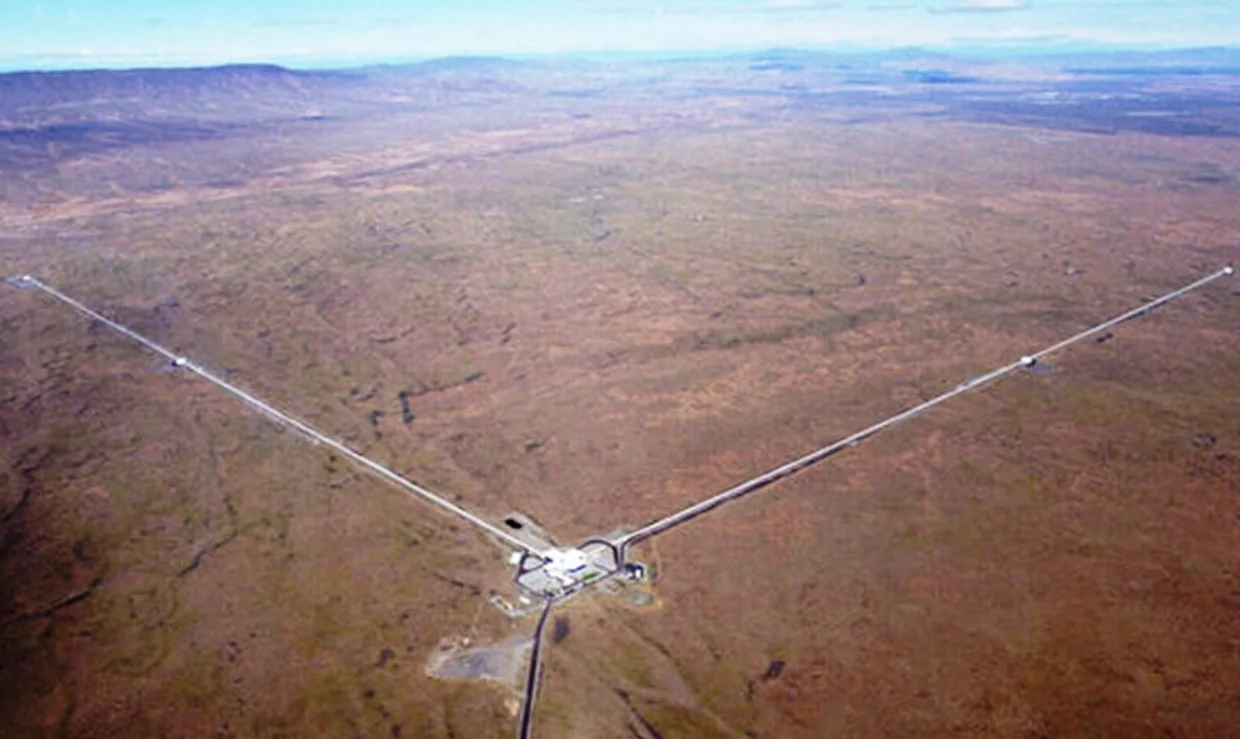
Sounds Of Spacetime
On September 14, 2015, almost exactly a century after Einstein predicted the existence of gravitational waves, a screaming loud signal was observed in the LIGO detectors. Based on how the arms of the LIGO detectors wiggled, we could tell a lot about the system that created the gravitational-wave signal: two black holes about a billion lightyears away, each about 30 times the mass of the Sun, spiraling towards one another and merging. This signal was one of the most monumental discoveries in modern physics, and was awarded the Nobel Prize in Physics in 2017. For the first time, we were able to hear the sounds of spacetime and use gravitational waves as a new sense to collect information from the universe!
Since this discovery, the field of gravitational-wave astronomy has exploded. The last full observing run of gravitational-wave detectors completed in 2020, and at that time nearly 100 confident gravitational-wave events were observed. These didn’t just come from merging black holes; the dense remnant cores of massive stars called neutron stars were also observed in gravitational waves.
In fact, one infamous system of two merging neutron stars was observed in both electromagnetic and gravitational radiation—a “multi-messenger” event! When two neutron stars merge, they not only emit gravitational waves, but also a burst of high-energy radiation called a gamma-ray burst and an explosion powered by radioactive decay called a kilonova. Kilonovas create a beautiful light show and are responsible for synthesizing most of the heavy elements on the periodic table (so you can thank them for generating the gold, silver, and platinum we have here on Earth).
Despite the groundbreaking gravitational-wave discoveries during the first half-decade of observations, the field of gravitational-wave astronomy is still in its nascent stages. The network of gravitational-wave detectors turned back on for another observing run in May 2023. Soon after, another new and exciting system was observed.
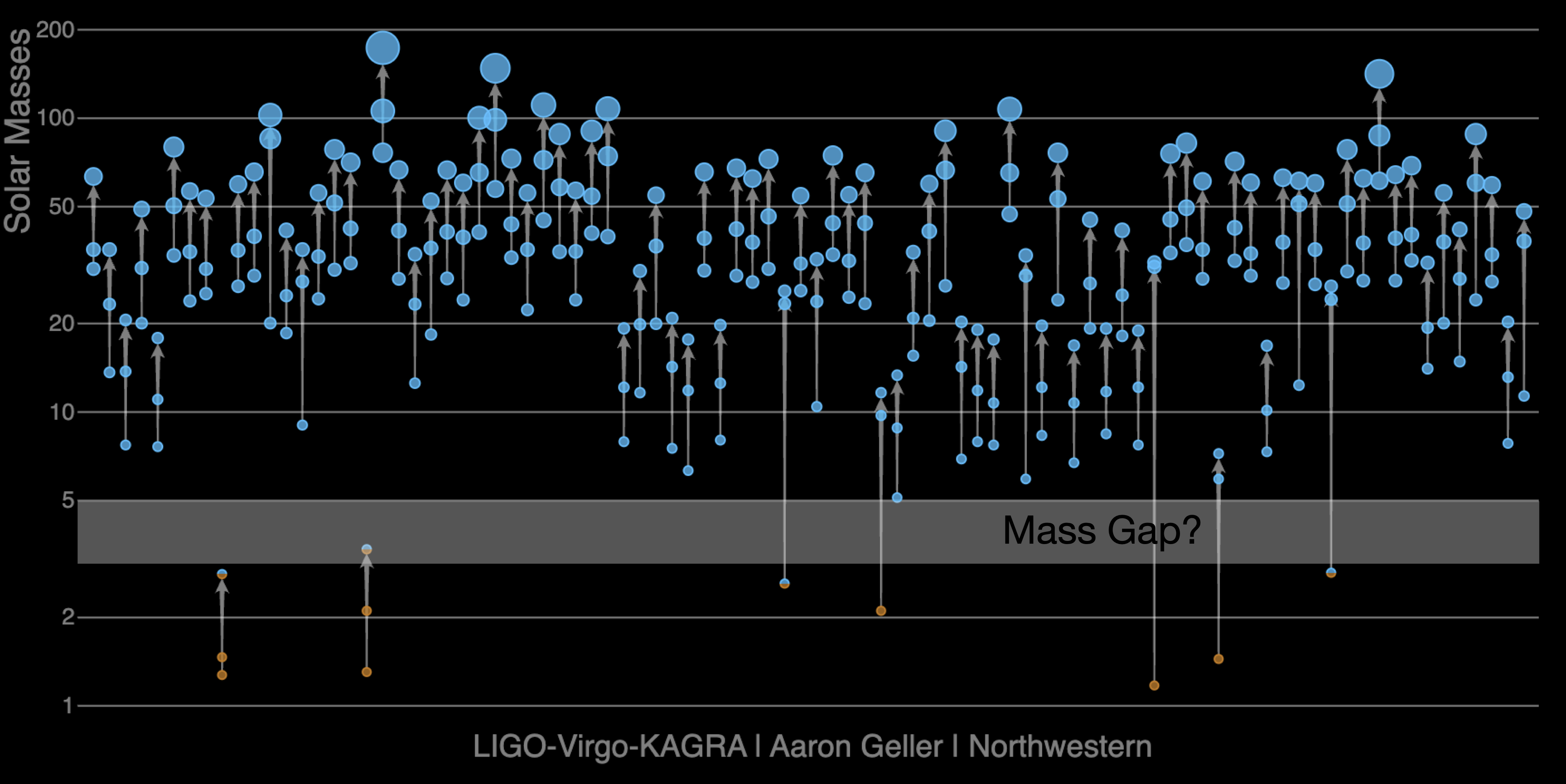
GW230529: A Black Hole In The Mass Gap
On May 29, 2023, gravitational waves were detected from a new type of system. I was fortunate to co-lead the discovery paper of this system on behalf of the almost 2,000 LIGO–Virgo–KAGRA collaboration scientists around the globe. The gravitational-wave event, dubbed GW230529 (“GW” for “gravitational wave” and its phone number “230529” for the year, month, and day of the detection), was seen only by the LIGO detector in Louisiana; all other detectors were either offline or not sensitive enough to see it.
Although we are confident that it is a real astrophysical event and not some source of noise, gravitational-wave detectors are somewhat like omnidirectional microphones. Without multiple detectors to triangulate the signal, we couldn’t determine where in the sky it came from. However, we can tell that the system was about 650 million lightyears away, meaning the gravitational waves were sent out a long, long time before even dinosaurs were around. We could also tell how massive the two objects in the system were, which was the real kicker.
Since the late 1990s, astronomers have hypothesized that there might be a “gap” between the heaviest neutron stars and the lightest black holes. Neutron stars can sustain themselves up to somewhere between two–three times the mass of the Sun before they can’t withstand the force of gravity anymore and collapse into a black hole (the exact “maximum mass” of a neutron star is a hot topic in astrophysics).
We’ve also indirectly inferred the masses of black holes in our own galaxy, the Milky Way, in systems called X-ray binaries. An X-ray binary is where a black hole is in a binary system with a star and stealing material from it. Based on how the star moves in the sky, we can tell the mass of the invisible black hole. It turns out that the lightest black holes observed in the Milky Way were no less than five times the mass of the Sun! Therefore, there seemed to be a gap in the masses of neutron stars and black holes that is between three–five times the mass of the Sun.
Is there a reason these lightweight black holes don’t form? Astronomers came up with theories about how the supernovae that form black holes can avoid this regime of masses. However, it is also possible that there is something we don’t quite understand about the biases of observing black holes in X-ray binary systems.
The black hole in GW230529 falls squarely in this “mass gap,” with a mass that is likely three–four times the mass of the Sun. This gravitational-wave event is one of the best pieces of evidence that lightweight black holes can exist in nature. The black hole in the system is also in the running for being the lightest black hole ever observed!
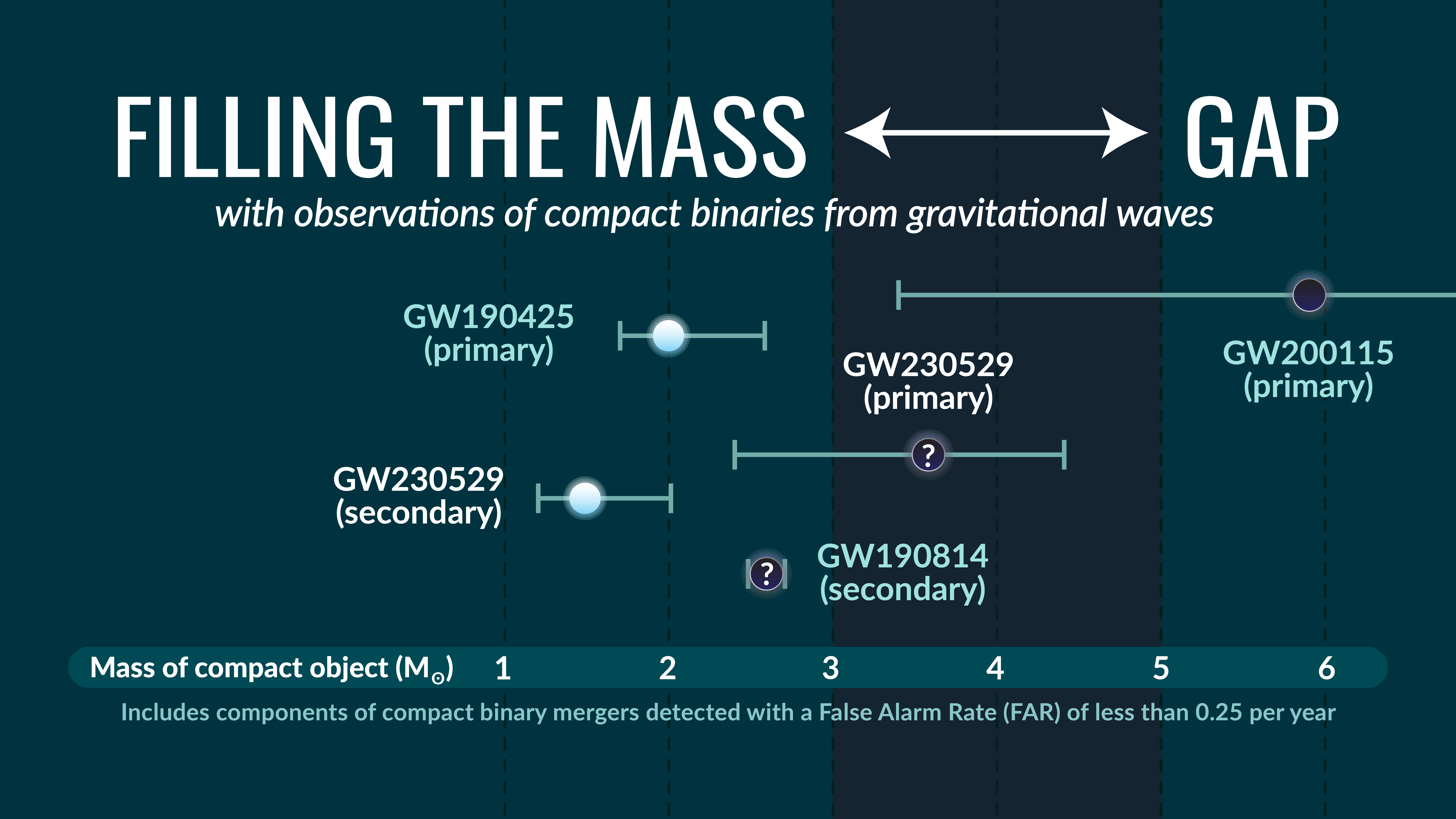
Despite how much mass they contain, black holes are amazingly small for their weight. At a few times more massive than the Sun, the black hole we observed could fit comfortably within the city of Chicago! This is wild, considering that we can see the way it distorts spacetime at a distance of 650 million lightyears—about four billion trillion miles.
The lighter object in the system was likely a neutron star. When neutron stars merge with another compact object like a black hole or another neutron star, they can get ripped apart and create a kilonova. However, if a neutron star merges with a black hole that is too heavy, it will get swallowed whole by the black hole before it can get torn to shreds, without emitting light or synthesizing heavy elements. Although we did not observe a kilonova alongside GW230529 (we couldn’t tell where in the sky it came from, which makes it exceedingly difficult to find an electromagnetic counterpart), the small black hole in the GW230529 system also tells us that black holes can indeed tear apart neutron stars before swallowing them whole.
More exciting gravitational-wave discoveries are on the horizon. Until then, keep looking up!
Adler Skywatch: May 2024
Header Image: An enhanced image of the constellation Boötes the Herdsman, with the lines between the stars drawn to show the constellation. Boötes the Herdsman will be visible in the east-southeast sky in May, 2024.
The planets may be hard to see, but there’s still a lot to look for in the night sky this month, May, 2024.
The two brightest planets, Venus and Jupiter, appear too close to the Sun this month to be readily observable. To see any of the other planets in our solar system without using optical aids, you’ll need to look shortly before dawn this month.
Stargazing For Early Risers
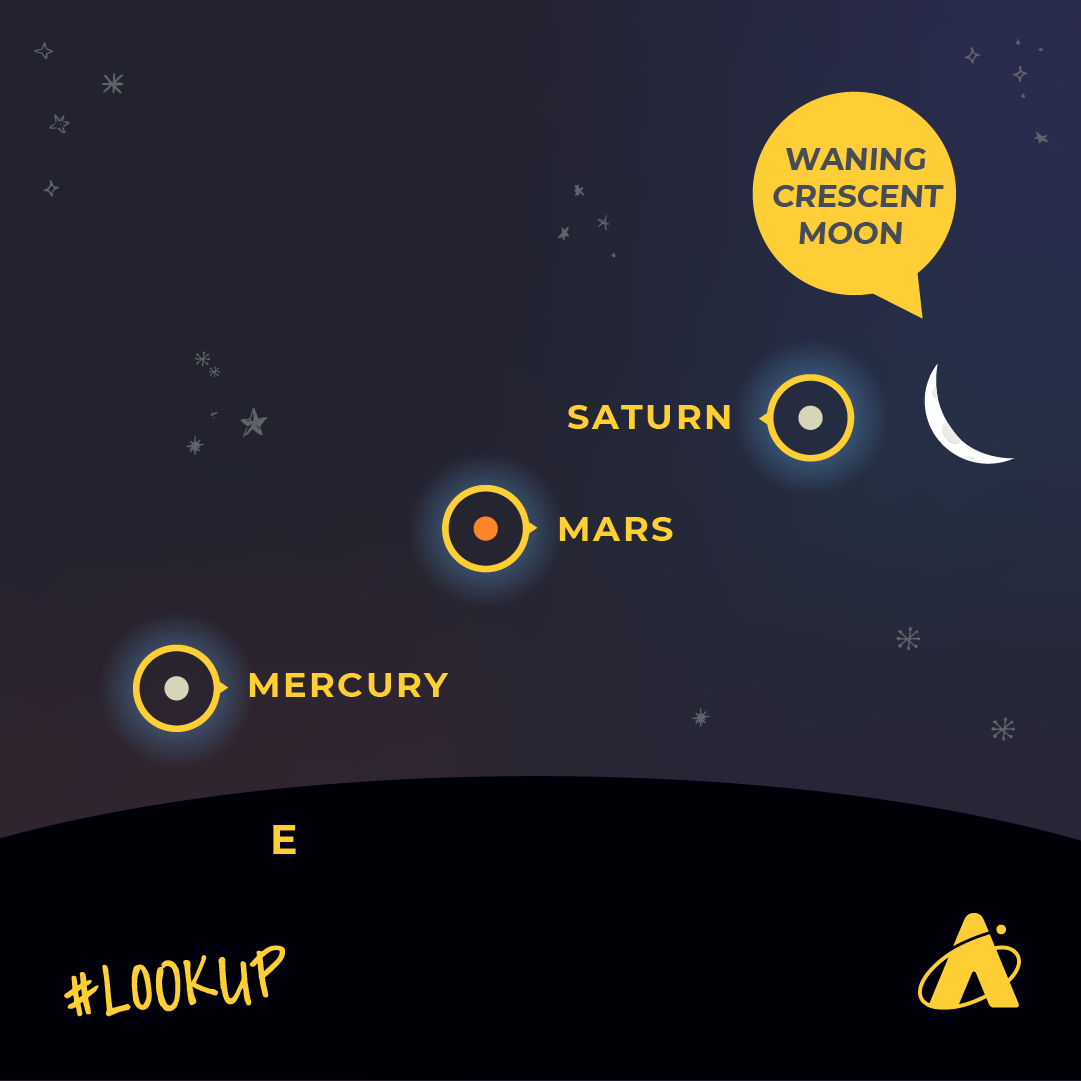
The planet Saturn rises in the east-southeast at the beginning of morning twilight early in the month, and later in the month, it rises shortly before the start of morning twilight. It shines at slightly below magnitude-one, which makes it brighter than any star within 50 degrees for the first half of the month. When Saturn gets about 15–20 degrees above the horizon, look slightly below and to the left to spot the planet Mars. It, too, is shining slightly below first-magnitude. You can also distinguish the two by color—Mars is more noticeably orange, while Saturn is more of a pale tan color.
Early in the month, Mars and Saturn appear about 15 degrees apart. Before dawn on May 4, a waning crescent Moon appears between Saturn and Mars. The two planets appear to gradually move apart from each other as the mornings pass. By the end of the month, Saturn and Mars appear more than 30 degrees apart. The last morning of the month, Saturn appears very close to a waning crescent Moon.
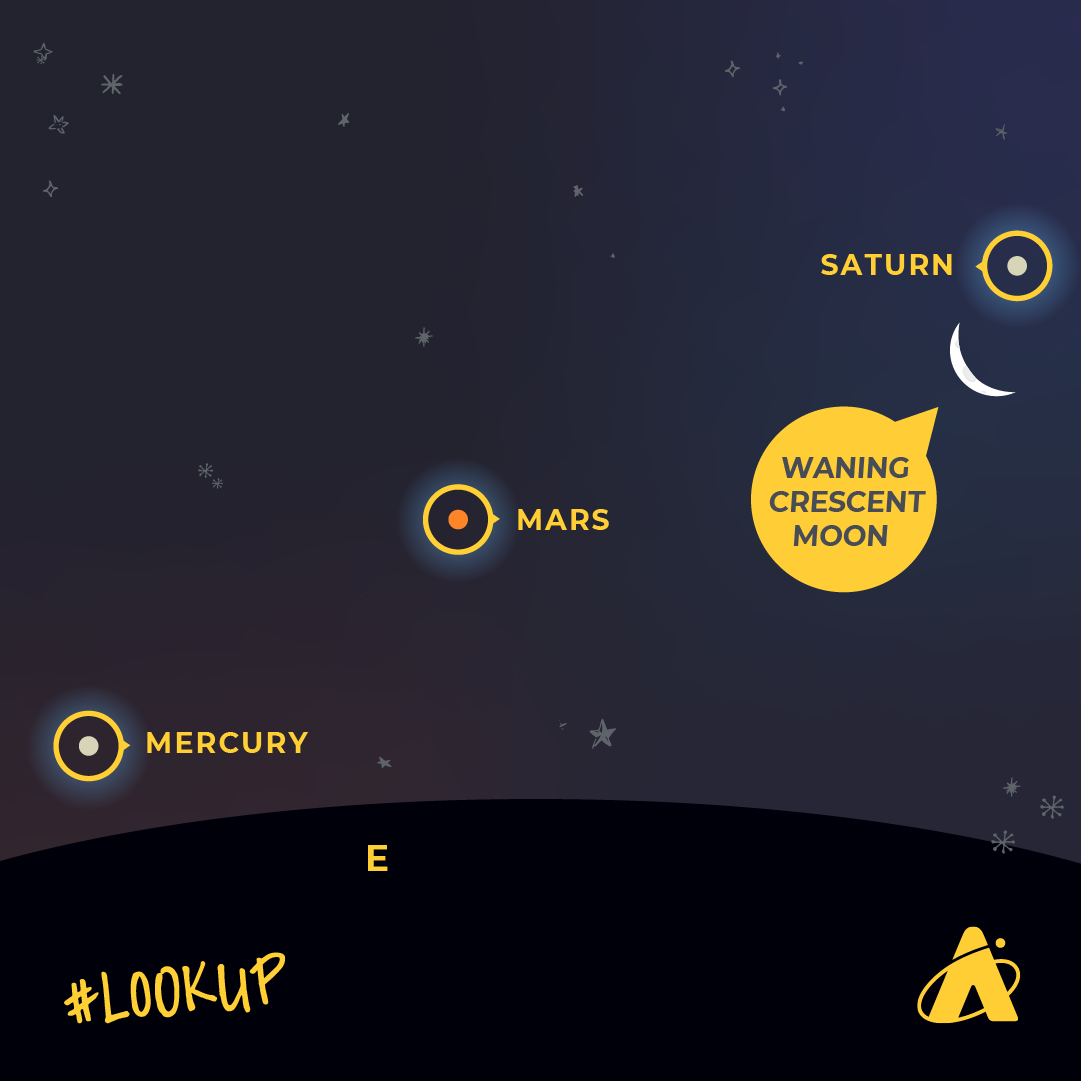
If you trace an imaginary line from Saturn down past Mars, very close to the eastern horizon, you may be able to spot the planet Mercury! It’s a little brighter than both Saturn and Mars this month—but Mercury is very close to the Sun and each morning the Sun rises a little earlier. So Mercury is very difficult, if not impossible, to see in the Sun’s glare. To protect your eyes, do not look for Mercury within a half-hour of sunrise.
About halfway through the month until its end, if you’re still up before dawn looking at planets, you may notice a star about 25 degrees to the lower-right of Saturn. That’s Fomalhaut, the brightest star in the constellation Piscis Austrinus, or the Southern Fish. Fomalhaut is usually known as an autumn star. The winter season has many bright stars in the night sky; and summertime has the bright Summer Triangle asterism. In fall, there are not many bright stars in the evening sky. We start seeing Fomalhaut in the morning in our spring skies and it will rise a little earlier each day until we see it in our early-evening fall skies.
Evening Stargazing
Evenings in springtime have their own bright stars too. One of the night sky’s brightest stars, Arcturus, is in the constellation Boötes the Herdsman. This month, it’s high in the east-southeast during evening twilight. About 30 degrees below and to the right of Arcturus is Spica, the brightest star in the constellation Virgo the Maiden. The night of May 19, a waxing gibbous Moon appears near Spica.
Another bright spring star to look for is Regulus, the brightest in the constellation Leo the Lion. It’s high in the southwest sky during evening twilight this month. The night of May 15, it’s near a first-quarter Moon.
Moon Phases
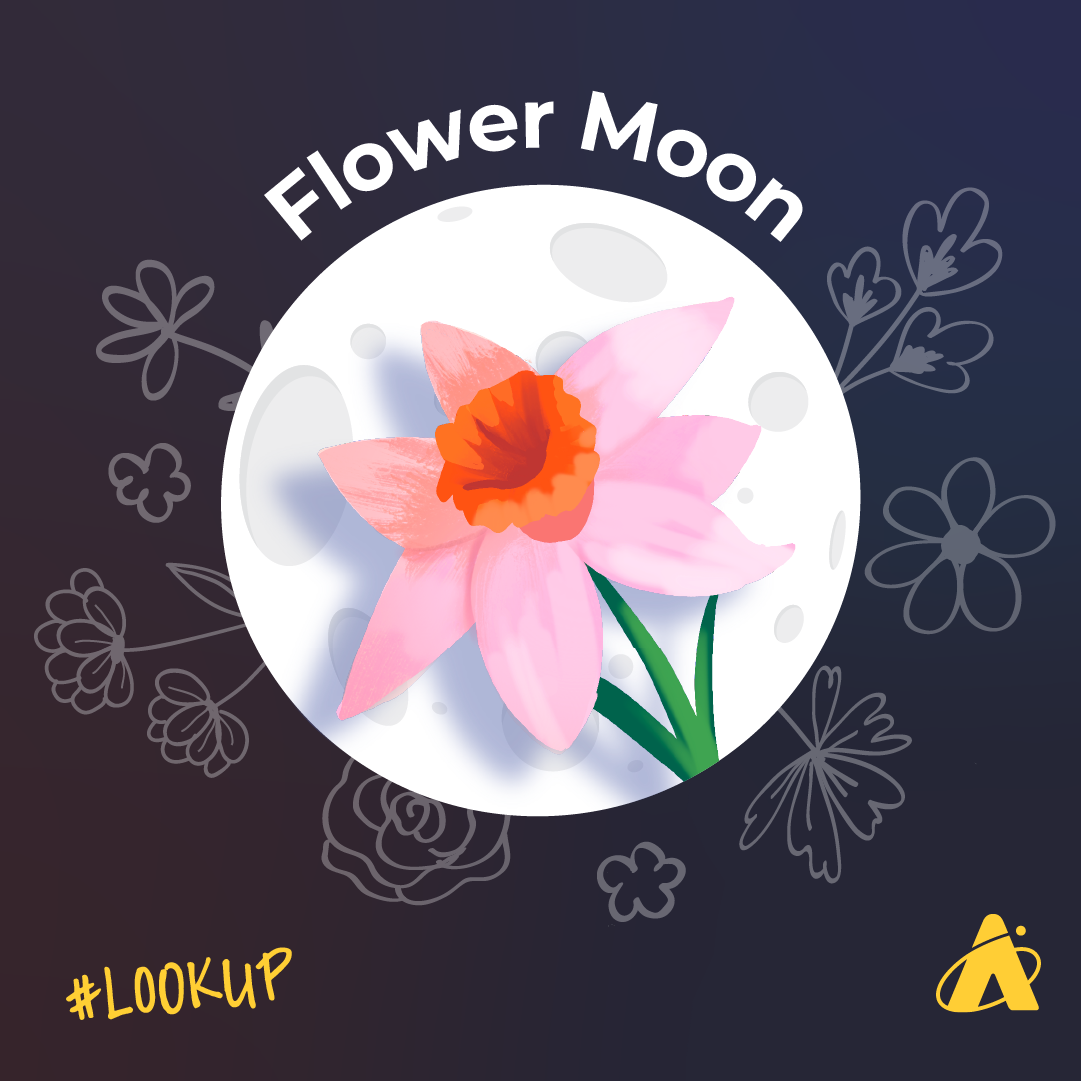
Last Quarter Moon: May 1
New Moon: May 7
First Quarter Moon: May 15
Full Moon: May 23
Last Quarter Moon: May 30
Please note: these descriptions are for the Chicago area, using Central time.
Subscribe To Skywatch Wednesday This May!
Tour the sky with the Adler Planetarium’s Theaters Manager, Nick, in Skywatch Wednesday. Nick uses cutting edge visualizations, NASA images, and astrophotography to show you what you can see in the night sky throughout the year.
Check out Nick’s latest episode for your ultimate guide to spring stargazing and the April solar eclipse! Don’t miss your chance to see Orion the Hunter and learn how to find constellations like Leo, Ursa Major, Boötes, and Virgo; and so much more!
Learn From Our Astronomy Educators!
Watch exclusive live episodes of Sky Observers Hangout this May! Learn how to observe upcoming cosmic happenings, enhance your astrophotography skills, and see celestial objects through a telescope virtually with our astronomy educators.
In our latest episode, Michelle and Hunter share everything you need to know to prepare for the total solar eclipse that passed across North America on April 8, 2024. Special guests from NASA Edge, Southern Illinois University, and by legendary meteorologist Tom Skilling so to help you get equipped to eclipse!




